Students get through AP Inter 1st Year Chemistry Important Questions 7th Lesson Chemical Equilibrium and Acids-Bases which are most likely to be asked in the exam.
AP Inter 1st Year Chemistry Important Questions 7th Lesson Chemical Equilibrium and Acids-Bases
Very Short Answer Questions
Question 1.
State Saw of chemical equilibrium.
Answer:
Law of chemical equilibrium:
In a balanced chemical equation, the ratio of the product of molar concentrations of the products raised to their respective stoichiometric coefficients to the product of the concentrations of the reactants raised to their individual stoichiometric coefficients, is a constant, at a given temperature.
Question 2.
Can equilibrium be achieved between water and its vapours in an open vessel?
Answer:
No. In an open vessel, the vapours escape into atmosphere. Hence the rate of evaporation will be more than the rate of condensation.
So equilibrium cannot be achieved.
Question 3.
Why the concentrations of pure liquids and pure solids are ignored from equilibrium constant expressions.
Answer:
The concentrations of pure solids and pure liquids are taken as unity (1). This value T does not effect the value of Kc.
Hence concentrations of pure solids and pure liquids are ignored in the expressions.
Question 4.
What is homogeneous equilibrium? Write two homogenous reactions. [IPE’ 14]AP 17,18]
Answer:
When the reactants and products are in the same physical state then the equilibrium is called homogeneous equilibrium.
Ex1: H2(g) + I2(g) ⇌ 2HI(g)
Ex2: N2(g) +3H2(g) ⇌ 2NH3(g)
Question 5.
What is heterogeneous equilibrium? Write two heterogeneous reactions. [AP 17,18]
Answer:
When the reactants and products are in different physical states then the equilibrium is said to be heterogeneous equilibrium.

![]()
Question 6.
Write reaction quotient, Q for each of the following reactions.

Answer:
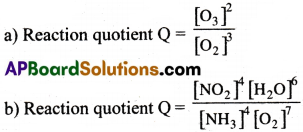
Question 7.
Define equilibrium constant.
Answer:
Equilibrium constant:
In a balanced chemical reaction, the ratio of the product of molar concentrations of products to the product of molar concentrations of reactants, at a given temperature, is called equilibrium constant.
Question 8.
The equilibrium constant expression for

Write the balanced chemical equation corresponding to this expression.
Answer:
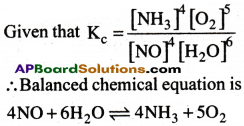
Question 9.
Write the relation between Kp and Kc.
Answer:
Kp = Kc (RT)∆n
Kp = equilibrium constant in terms of partial pressures
Kc = equilibrium constant in terms of molar concentrations
R = gas constant
T = Temperature in kelvin
∆n = Difference in the number of moles gaseous products and reactants.
Question 10.
Under what conditions for a reaction Kp and Kc are numerically equal?
Answer:
If the number of moles of gaseous products = Number of moles of gaseous reactants
then np – nR = 0 ⇒ ∆n = 0
Now, Kp = Kc (RT)∆n = Kc (RT)0
= Kc(1) = Kc
∴ Kp = Kc, when ∆n=0.
Question 11.
Give two chemical equilibrium reactions for which Kp = Kc
Answer:

Question 12.
Give two chemical equilibrium reactions for which Kp > Kc [AP 20]
Answer:

Question 13.
Give two chemical equilibrium reactions for which Kp < Kc
Answer:
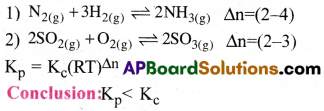
Question 14.
Write the equations for the conversion of Kc to Kp for each of the following reactions.

Answer:
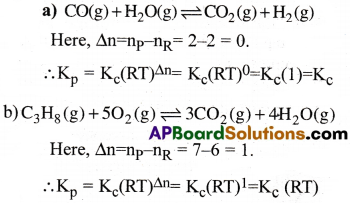
Question 15.
What are the factors which influence the chemical equilibrium?
Answer:
Factors influencing chemical equilibrium:
- Concentration of reactants and products.
- Temperature of reaction.
- Pressure of reaction.
- Addition of Inert gas
![]()
Question 16.
What is the effect of pressure on a gaseous chemical equilibrium? [AP 19]
Answer:
1) If the number of moles of gaseous products is equal to the number of moles of gaseous reactants (∆n = nP – nR = 0) then pressure has no effect on the equilibrium.
2) If ∆n ≠ 0 then
(a) Increase of pressure, shifts the position of equilibrium in the direction of decreasing the number of moles.
Ex: N2(g) +3H2(g) ⇌ 2NH3(g), ∆n < 0 (fw)
(b) Decrease of pressure, shifts the position of equilibrium in the direction of increasing the number of moles.
Ex: PCl5(g) ⇌ PCl3(g) +Cl2(g), ∆n > 0(bw)
Question 17.
What is the effect of increase in concentration of reactants of a chemical reaction at equilibrium?
Answer:
Increase in the concentration of reactants of a chemical reaction, at equilibrium, favours the forward reaction.
Question 18.
Can catalyst disturb the state of equilibrium?
Answer:
No. When a catalyst is added, the state of equilibrium is not disturbed, but equilibrium is attained quickly. Because a catalyst increases both the rate of forward and backward reaction, to the same extent.
Question 19.
On which factor, the equilibrium constant value changes?
Answer:
Temperature. Increase in temperature favours the endothermic reaction. Hence the equilibrium constant changes.
Question 20.
The equilibrium constants of a reaction at 27°C and at 127°C are 1.6 × 10-3 and 7.6 × 10-2 respectively. Is the reaction exothermic or endothermic.
Answer:
Kc = 7.6 × 10-2, at T27°C
Kc = 1.6 × 10-3, at 27°C
Thus, the value of equilibrium constant (Kc) is increased with increase in temperature. Hence the reaction is endothermic.
![]()
Question 21.
What is the effect of temperature on a system at equilibrium?
Answer:
Increase in temperature of a reaction mixture, at equilibrium, favours the endothermic reaction.
Decrease in temperature of a reaction mixture, at equilibrium, favours the exothermic reaction.
Question 22.
For an exothermic reaction, what happens to the equilibrium constant if temperature is raised?
Answer:
In an exothermic reaction when the temperature is raised, the value of equilibrium constant decreases. .
Question 23.
What kind of equilibrium constant can be calculated from ∆G° value for a reaction involving only gases?
Answer:
We know ∆G = ∆G° + RTlnQ ……….. (1)
At equilibrium, ∆G = 0 and Q = K
∴ from (1), 0 = ∆G° + RT/nK
⇒ ∆G° = -RT/nK
![]()
Here, K = Equilibrium constant
Hence, we can calculate the equilibrium constant (Kp), when the reaction is involved only with gases.
Question 24.
What is a Bronsted base? Give one example? [AP 16][TS 19]
Answer:
A chemical substance whose molecules or ions have a tendency to gain proton(s) from a donor, is called a Bronsted base.
Ex: H2O, NH3, Cl–
Question 25.
What is Lewis acid? Give one example? [AP 15,16][TS 18,22]
Answer:
A chemical substance whose molecules or ions, have a tendency to accept an electron pair, to form a coordinate covalent bond with the donor is called Lewis acid.
Ex: BF3, BCl3, H+
Question 26.
What is meant by ionic product of water? [TS 18][AP 16]
Answer:
The product of the concentrations of H+ and OH– ions, in water, at a given temperature, is called ionic product of water.
Ionic product of water, Kw = [H+][OH–]
Question 27.
What is the value of Kw? What are its units?
Answer:
Kw = 1.0 × 10-14 mol²/L², at 25°C
Units: mol²/L²
![]()
Question 28.
What is the effect of temperature on ionic product of w ater?
Answer:
As the temperature increases, the degree of ionization of water increases. Hence the value of ionic product (Kw) also increases.
Question 29.
H2O + H2O ⇌ H3O+ + OH–
The ionic product of water is 1 × 10-14 at 25°C and 3 × 10-14 at 40°C
Is the above process endothermic or exothermic?
Answer:
Kw = 3 × 10-14 mo²/L², at 40°C
Kw = 1 × 10-14 mol²/L², at 25°C
Here, the value of Kw is increased with increase of temperature. Hence the given reaction is an endothermic reaction
Question 30.
All Bronsted bases are Lewis bases. Explain.
Answer:
Bronsted base is a proton acceptor.
Lewis base is an electron pair donor.
NH3 is a Bronsted base it can accept a proton. In accepting a proton, it donates an electron pair.
Thus, a Bronsted base, to accept a proton must donate an electron pair.
So all the Bronsted bases are Lewis bases.
Question 31.
All Lewis acids are not Bronsted acids. Why?
Answer:
Lewis acid is an electron pair acceptor.
Bronsted acid is a Proton donor.
All the Lewis acids may not have hydrogen to donate protons.
Hence all Lewis acids are not Bronsted acids BF3 is a Lewis acid since it can accept an electron pair from other substances.
But BF3 can’t donate protons. Hence, It is not a Bronsted acid.
Question 32.
What is degree of ionization?
Answer:
Degree of ionization (α) :
The ratio between the number of molecules ionised and the total number of molecules of an acid or base.
Question 33.
What is the measure of strength of an acid and base?
Answer:
Strength of an acid is measured by the acid dissociation constant (Ka)
Strength of a base is measured by the base . dissociation constant (Kb)
Strength of an acid or base can be measured in terms of pH
![]()
Question 34.
Give two examples of salts whose aqueous solutions are basic.
Answer:
Aqueous solutions of salts of weak acid and strong base, have basic nature.
Ex: Sodium acetate CH3COONa,
Sodium carbonate Na2CO3
Question 35.
Give two examples of salts whose aqueous solutions are acidic.
Answer:
Aqueous solutions of salts of strong acid and weak base, have acidic nature.
Ex: NH4Cl, CuSO4, Al2(SO4)3
Question 36.
What equation is used for calculating the pH of an acid buffer?
Answer:
Hendersen’s equation:

Question 37.
Phosphoric acid (H3PO4) have three ionization constants Ka1, Ka2 and Ka3. Among these ionization constants which has a lower value? Give reason for it?
Answer:
Among Ka1, Ka2, Ka3 the value of Ka3 is low.
Reason:
Due to common ion effect. It becomes more difficult to remove a positively charged proton from doubly charged anion HPO-24 when compared to H2PO–4, H3PO4
Question 38.
Ice melts slowly at high altitudes. Explain. Why?
Answer:
At higher altitudes, atmospheric pressure is very low. Hence ice melts slowly.
Question 39
Define Basicity of acid and Acidity of base. [AP 18]
Answer:
The number of replaceable H+ ions of an acid is known as Basicity of acid.
The number of replaceable OH– ions of an base is known as Acidity of base.
Short Answer Questions
Question 1.
Write expression for the equilibrium constant Kc for each of the following reactions.
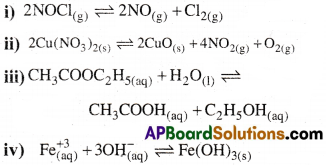
Answer:
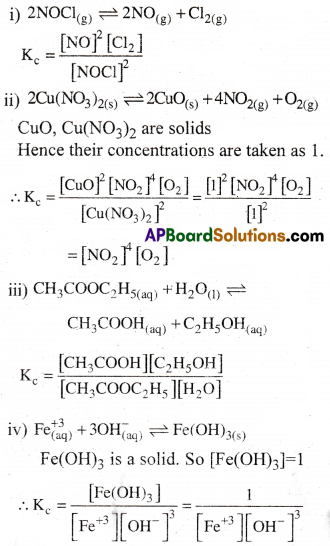
Question 2.
Derive the relation between KP & KC for the equilibrium reaction: [TS 19,22][AP 15,19]
N2(g) + 3H2(g) ⇌ 2NH3(g)
Answer:
N2(g) + 3H2(g) ⇌ 2NH3(g)
⇒ ∆n = nP – nR = 2-(1 + 3) = -2
We know Kp = Kc(RT)∆n = Kc(RT)-2
Here Kp < Kc
![]()
Question 3.
Define equilibrium constant. Write the equilibrium constant expression for the reaction of H2(g) + I2(g) ⇌ 2HI(g) and its reverse reaction. How are the two equilibrium constants related?
Answer:
Equilibrium Constant(Kc):
The ratio of product of the equilibrium concentrations of the products to that of the reactants, with each concentration tenn raised to the power equal to the stoichiometric coefficient of the substance, in the balanced chemical equation, is called Equilibrium Constant.
The given reaction:
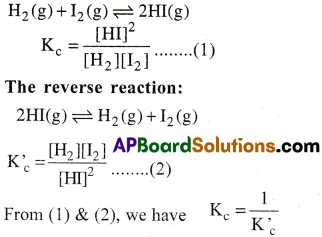
∴ Equilibrium constant for a given reaction is the inverse of the equilibrium constant for the reverse reaction.
Question 4.
How does the value of equilibrium constant predict the extent of reaction?
Answer:
Predicting the extent of a reaction:
The numerical value of the equilibrium constant for a reaction indicates the extent of the reaction. But equilibrium constant does not give any information about the rate at which the equilibrium is reached.
Values of Kc verses Extent of reactions:
i) If Kc is very high (Kc >10³) then the reaction takes place in the forward direction, as products predominate over reactants. Here the reaction proceeds ‘nearly to completion’.
Ex: H2(g) + Cl2(g) ⇌ 2HCl(g)
Here, Kc =4.0 × 1031 at 300°C
ii) If Kc is very low (Kc < 10-3) then the reaction takes place in the backward direction, as reactants predominate over products. Here the reaction proceeds ‘rarely or slow’.
Ex: N2(g) + O2(g) ⇌ 2NO(g)
Here, Kc = 4.8 × 10-31 at 298°C
iii) If Kc is the range of 10-3 to 10³ then appreciable concentrations of both reactants and products are present in the equilibrium mixture. When Kc = 1 then the reaction proceeds to an extent of 50%
Ex: H2(g) + I2(g) ⇌ 2HI(g)
Here, Kc = 57.0 at 700K.
Question 5.
State law of chemical equilibrium? What is Kc for the following equilibrium when the equilibrium concentration of each substance is [SO2] = 0.60 M, ]O2] = 0.82 M and [SO3] =1.90 M?
2SO2(g) + O2(g) ⇌ 2SO3(g)
Answer:
Law of chemical equilibrium :
In a balanced chemical equation, the ratio of the product of molar concentrations of the products raised to the respective stoichiometric coefficients to the product of the concentrations of the reactants raised to their individual stoichiometric coefficients, gives a constant value, at a given temperature. The given equation is
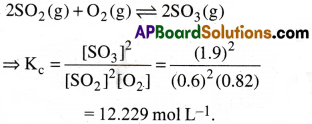
Question 6.
Why sealed soda water bottle on opening shows the evolution of gas with effervescence?
Answer:
The sealed soda water contains CO2 gas dissolved in water under high pressure. When the bottle is opened the pressure decreases and solubility of CO2 decreases. So evolution of CO2 takes place with effervescence.
Question 7.
Explain the significance of
a) a very large value of K,
b) a very small value of K and
c) a value of K of about 1.0
Answer:
a) When Kc is very large, (Kc > 10³), the forward reaction takes place to more extent and backward reaction to less extent. So the net reaction goes to almost completion.
b) If Kc is very small(Kc < 10-3), the forward reaction takes place to a small extent only. So the net reaction proceeds to a small extent only.
c) If Kc = 1 then the rate constants of both forward backward reactions are equal. This indicates that the reaction proceeds to an extent of 50%.
Question 8.
Why is it useful to compare Q with K? What is the situation when
(a) Q = K (b) Q < K (c) Q > K
Answer:
The values of K and Q are useful in predicting the direction of the reaction.
a) If Q = K, the reaction is at equilibrium and no net reaction occurs.
b) If Q < K, the net reaction takes place in the forward direction.
c) If Q > K, the net reaction takes place in the backward direction.
![]()
Question 9.
For the reaction
Cl2(g) + F2(g) ⇌ 2ClF(g), Kc = 19.9
What will happen in a mixture originally containing [Cl2] = 0.4 molL-1. [F2] = 0.2 mol L-1 and [Cl F] = 7.3mol L-1.
Answer:
Given reaction is

Also we have Kc = 19.9 ⇒ QC > KC
∴ The reaction takes place in the backward direction with reactant side.
Question 10.
Predict which of the following reaction will have appreciable concentration of reactants and products:

Answer:
Among the given equations, the value of Kc is nearer to 1 (in the range of 10-3 to 10³) in the third equation(c), where Kc = 1.8.
So appreciable concentrations of reactants and products are present in equilibrium mixture of third equation(c).
Question 11.
How to recognise the conditions under which changes in pressure would effect system in equilibrium.
Answer:
Pressure has no effect on reaction involving solids and liquids. It is because the volume of solids and liquids do not be effected by pressure.
Pressure has effect on the equilibrium reactions containing gaseous substances. It depends on the value of (∆n) of the reaction.
(a) ∆n = 0 then pressure has no effect on the equilibrium.
(b) If ∆n ≠ O then
(i) Increase of pressure, shifts the position of equilibrium in the direction of decreasing the number of moles.
Ex: N2(g) +3H2(g) ⇌ 2NH3(g), ∆n < 0
(ii) Decrease of pressure, shifts the position of equilibrium in the direction of increasing the number of moles.
Ex: PCl5(g) ⇌ PCl3(g) + Cl2(g), ∆n > 0
Question 12.
What property of a reaction can be used to predict the effect of a change in temperature on the magnitude of an equilibrium constant?
Answer:
In general, the temperature dependence of the equilibrium constant depends on the sign of ∆H for a given reaction.
The equilibrium constant for an exothermic reaction decreases as the temperature increases. Here the sign of ∆H is negative.
The equilibrium constant for an endothermic reaction increases as the temperature increases. Here the sign of ∆H is positive. Thus changes in temperature depend upon the sign of ∆H.
Question 13.
Docs the number of moles of reaction products increase, decrease, or remains same when each of the following equilibria is subjected to a decrease in pressure by increasing the volume?
i) PCl5(g) ⇌ PCl3(g) + CI2(g)
ii) CaO(s) + CO2(g) ⇌ CaCO3(s)
Answer:
According to Le Chatelier’s principle, if pressure is decreased on the equilibrium mixture, the equilibrium shifts in the direction so that the decreased pressure is nullified.
i) PCl5(g) ⇌ PCl3(g) + CI2(g)
i) In the above reaction, the number of gaseous molecules of products(2) is more than the number of gaseous molecules of the reactants(l). So the reaction proceeds in the forward direction. So the number of moles of products increases.
ii) CaO(s) + CO2(g) ⇌ CaCO3(s)
ii) In the above reaction, gaseous molecule (CO2) is present in the reactant. When pressure is decreased, the number of CO2 molecules increases on the reactant side. To increase the number of CO2 moles, CaCO3 should decompose. So the number of moles of product decrease.
![]()
Question 14.
Which of the following reactions will get affected by increasing the pressure? Also mention whether change will cause the reaction to go into forward or backward direction.
i) COCl2(g) ⇌ CO(g) + Cl2(g)
ii) CH4(g) + 2S2(g) ⇌ CS2(g) + 2H2S(g)
iii) CO2(g) + C(s) ⇌ 2CO(g)
iv) 4NH3 (g) + 5O2 (g) ⇌ 4N0(g) + 6H2O(g)
Answer:
According to Le Chatelier’s principle, when pressure is increased on the equilibrium mixture, the equilibrium shift in the direction where the number of gaseous molecules is less.
i) COCl2(g) ⇌ CO(g) + Cl2(g)
In this reaction, the number of gaseous reactant molecules (1) is less than the total number of gaseous molecules (2) of products. So increase in pressure shifts the equilibrium in the backward direction.
ii) CH4(g) + 2S2(g) ⇌ CS2(g) + 2H2S(g)
In this reaction, the total number of gaseous reactant molecules (3) is equal to the total number of gaseous product molecules (3). So pressure has no effect on this equilibrium.
iii) CO2(g) + C(s) ⇌ 2CO(g)
In this reaction, the number of gaseous reactant molecules (1) is less than the total number of gaseous product molecules (2). So increase in pressure, shifts the equilibrium in the backward direction.
iv) 4NH3 (g) + 5O2 (g) ⇌ 4N0(g) + 6H2O(g)
In this reaction, the sum of the number of gaseous reactant molecules (9) is less than the sum of the number of the gaseous product molecules (10). So increase in pressure, shifts the equilibrium in the backward direction.
Question 15.
How will an increase in pressure affect each of the following equilbria? An increase in temperature?
i) 2NH3 (g) ⇌ N2 (g) + 3H2 (g), ∆H = 92kJ
ii) N2(g) + O2(g) ⇌ 2NO(g) ∆H = 181 kJ
iii) 2O3(g) ⇌ 3O2(g) ∆H = -285kJ
iv) CaO(S) + CO2(g) ⇌ CaCO3(S) ∆H = -176kJ
Answer:
According to Le Chatelier’s principle increase in pressure shifts the equilibrium in the direction where the number of gaseous molecules is less.
Increase in temperature favours the endothermic reaction, while decrease in temperature favours the exothermic reaction.
i) 2NH3 (g) ⇌ N2 (g) + 3H2 (g), ∆H = 92kJ
Here, the number of gaseous reactant molecules (2) is less than the sum of the total number of product molecules (4). So increase in pressure, shifts the equilibrium in the backward direction.
Increase in temperature shifts the equilibrium in the forward direction.
ii) N2(g) + O2(g) ⇌ 2NO(g) ∆H = 181 kJ
Here, the sum of the gaseous reactant molecules is equal to the sum of the gaseous product molecules. So pressure has no affect on the equilibrium.
Increase in temperature favours the forward direction.
iii) 2O3(g) ⇌ 3O2(g) ∆H = -285kJ
Here, the number of gaseous reactant molecules (2) is less than the number of gaseous product molecules. So increase in pressure shifts the equilibrium in the backward direction.
Increase in temperature shifts the equilibrium in the backward direction.
iv) CaO(S) + CO2(g) ⇌ CaCO3(S) ∆H = -176kJ
In this reaction, there is only one gaseous reactant molecule. No gaseous product molecules are present. So increase in the pressure shift the equilibrium in the forward direction.
Increase in temperature shifts the equilibrium in the backward direction.
Question 16.
The dissociation of HI is independent of pressure, while the dissociation of PCl5 depends upon the pressure applied. Explain.
Answer:
Dissociation of HI:
2HI(g) ⇌ H2(g) + I2(g)
Here nP = nR ⇒ ∆n = 0
∴ Pressure has no effect on the above reaction.
Dissociation of PCl5:
PCl5(g) ⇌ PCl3(g) +Cl2(g)
Here nP = 2 and nR = 1 ⇒ nP ≠ nR ⇒ ∆n ≠ 0
∴ This reaction is affected by pressure.
So dissociation of PCl5 depends upon the pressure.
Question 17.
Explain the terms: (i) Electrolyte (ii) Non-electrolyte (iii) Strong & weak electrolytes (iv) ionic equilibrium
Answer:
i) Electrolyte :
The substance which conducts electricity either in aqueous form (or) in fused state is known as Electrolyte. Ex: Aqueous salts, acids and bases.
ii) Non -electrolyte :
The substances which do not conduct electricity in their aqueous solutions are called non-electrolytes.
Ex: Glucose, Urea, Sucrose.
iii) Strong and Weak electrolytes :
The electrolytes which are almost completely ionised, in solutions are called strong electrolytes. The electrolytes which ionise weakly in their solutions are called weak electrolytes.
iv) Ionic Equilibrium :
The equilibrium that exists between neutral molecules and its ions in solution is called ionic equilibrium. Most ionic reactions are acid-base reactions.
Question 18.
Explain the terms:
i) extent of ionization and on what factors it depends (ii) dissociation (iii) ionization
Answer:
i) The extent of ionization is the ratio of number of molecules ionized to the total number of molecules of the substance. It depends on the polarity and strength of the covalent bond.
ii) Dissociation refers to the process of separation of ions in water which are already existing as such, in the solid solute of the given salt.
iii) Ionization refers to the process of splitting a neutral molecule into charged ions, in the solution.
![]()
Question 18.
Explain the Arrhenius concept of acids and bases. [TS 22]
Answer:
Arrhenius acid-base theory:
Acid :
A substance which dissociates to give H+ or H3O+ ions in aqueous solution is called acid.
Ex: HCl, HBr, HClO4, HNO3 etc.
Base :
The substance which dissociates to give OH– ions in aqueous solution is called a base.
Ex: NaOH, KOH, NH4OH etc.
Neutralisation :
The process in which the H+ ions from acid react with OH– ions from base to form undissociated water molecule is called neutralisation.
HCl + NaOH → NaCl + H2O
The basic neutralisation reactions is
H+(aq) + OH–(aq) → H2O(l)
Limitations:
- This theory is applicable to only aqueous solutions.
- It failed to explain acidic nature of CO2, SO2, and basic nature of NH3,CaO etc.
Question 19.
What is a conjugate acid-base pair? Illustrate with examples. [AP 16]
Answer:
An acid-base pair which differ only by proton is called conjugate acid base pair.

A base fonned by the loss of a proton by an acid is called conjugate base of the acid. An acid is formed by the gain of proton, by a base is called conjugate acid of the base. Acid-base pairs such as H2O & OH– and NH+4 & NH3 which are formed by loss or gain of a proton are called conjugate acid-base pair.
In the above given reaction, H2O & OH– and NH+4 & NH3 are conjugate acid-base pairs.
A strong acid would have large tendency to donate proton. Thus conjugate base of a strong acid would be a weak base. Similarly, conjugate base of a weak acid would be a strong base.
Question 20.
Acetic acid is a weak acid. List, in order of descending concentration, all of the ionic and molecular species present in 1M aqueous solution of acetic acid.
Answer:
Aqueous solution of CH3COOH contains H2O, CH3COOH, CH3COO–, H3O+, OH– In this solution ionic species are CH3COO–, H3O+, OH– which are produced from partial ionisation of H2O & CH3COOH.

The order of concentration of ionic species and molecular species:
[H2O]>[CH3COOH]>[H3O+] = [CH3COO–] >[OH–]
Question 21.
Show by suitable equations that each of the following species can act as a Bronsted acid.
a) H3O+ b) HCl c) NH3 d) HSO–4
Answer:
a) H3O+ + OH– → 2H2O
Here, H3O+ is donating a proton to OH– ion.
So it is a Bronsted acid.
b) HCl + H2O → H3O+ + Cl–
Here, HCl is donating a proton to H2O molecule. So it is a Bronsted acid.
c) NH3 + NH3 → NH+4+ + NH–2
Here, NH3 is giving H+ion to another NH3 molecule. So it is a Bronsted acid.
d) HSO–4 + H2O → SO-242 + H3O+
Here, HSO4 gives a proton to H2O, hence it is a Bronsted acid.
![]()
Question 22.
Show by suitable equations that each of the following spieces can act as a Bronsted base.
(a) H2O
(b) OH–
(c) C2H5OH
(d) HPO4-2
Answer:
(a) H2O + H+ → H3O+
H2O is accepting a proton.
SO it is a Bronsted base.
(b) OH– + H+ → H2O
OH– ion is accepting H+ ion.
So it is a Bronsted base.
(c) C2H5OH + H+ → C2H5O+H2
C2H5OH is accepting H+ ion.
So it is a Bronsted base.
(d) HPO-24 + H+ → H2PO–4
HPO-24 is accepting a proton.
So it is a Bronsted base.
Question 23.
The species : H2O, HCO–3, HSO–4 and NH3 can act both as Bronsted acids and bases. For each case give the corresponding conjugate acid and conjugate base. [AP 18]
Answer:
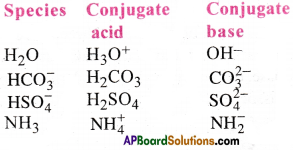
Question 24.
Write equation that shows H2PO–4 acting both as an acid and as a base.
Answer:
H2PO–4 + H2O → HPO2-4+ H3O+
Here H2PO–4 is giving a proton to H2O.
So it is an acid.
H2PO–4 + HCl → H3PO4 + Cl–
Here H2PO–4 is taking proton.
So it is a base.
Question 25.
Write the conjugate acid and conjugate base of each of the following: [AP 19,20,22]
a) OH–
b) H2O
c) HCO–3
d) H2O2.
Answer:
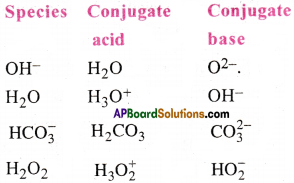
Question 26.
Identify and label the Bronsted acid and its conjugate base, the Bronsted base and its conjugate acid in each of the following equations.
a) H2SO4 + Cl– → HCl + HSO4
b) H2S + NH–2 → HS– + NH3
c) CN– + H2O → HCN + OH–
d) O2- + H2O → 2OH–
Answer:

i) H2SO4 can donate proton to Cl–. Hence it is a Bronsted acid and its conjugate base is HSO–4
Cl– can accept a proton from H2SO4.
So it is a Bronsted base and its conjugate acid is HCl.

H2S can donate a proton to NH–4
So it is a Bronsted acid and its conjugate base is HS–.
NH–2 can accept a proton from H2S.
So it is a Bronsted base and its conjugate acid is NH3

CN– can accept a proton from H2O.
So it is a Bronsted base and its conjugate acid is HCN.
H2O can donate proton from CN–.
So it is a Bronsted acid and its conjugate base is OH–.

Base Acid Conjugate conjugate Acid Base
O2- can accept a proton from H2O.
So it is a Bronsted base and its conjugate acid is OH–.
H2O can donate proton from O2-.
So it is a Bronsted acid and its conjugate base is OH–.
![]()
Question 27.
Classify the species AlCl3, NH3, Mg+2 and H2O into Lewis acids and Lewis bases and justify your answer?
Answer:
i) AlCl3 can accept an electron pair from
NH3. SO it is a Lewis acid.
AlCl3 + NH3 → [H3N → AlCl3]
ii) NH3 can donate an electron pair to H+. So it is a Lewis base.
NH3 + H+ → [NH4+]
iii) Mg2+ can accept an electron pair from H2O. SO it is a Lewis acid.
Mg2+ + 4H2O → [Mg(H2O)4]2+
iv) H2O can donate an electron pair to Cu+2. So it is a Lewis base.
Cu2+ + 4H2O → [Cu(H2O)4]2+
Question 28.
What are the strengths of conjugate bases of a strong acid and a weak acid?
Answer:
An acid which gives a proton easily is a strong acid. A conjugate base which cannot hold the proton strongly is a weak base. So the conjugate base of strong acid is weak base.
A strong base is that which can hold the proton strongly. So the conjugate base of a weak acid is a strong base.
Question 29.
What are the strength of conjugate acids of a strong base and weak base?
Answer:
A strong base is that which holds the proton strongly. So its conjugate acid is a weak acid.
A weak base that which cannot hold the proton strongly. So its conjugate is a strong acid.
Question 30.
Define Ionic Product of water. What is the value at room temperature? [APTS 17]
Answer:
The product of the concentrations of H+ and OH– ions, in water, at a given temperature, is called ionic product of water.
Ionic product of water Kw = [H+][OH–]
Kw = 1.0 × 10-14mol²/lit², at25°C
Units: mol²/lit²
Question 31.
Define pH. pH cannot be calculated directly from the molar concentration of a weak acid or weak base. Why? Derive an equation for the PH of a weak acid.
Answer:
The pH of a solution is defined as the negative value of the logarithm to base 10 of hydrogen ion concentration expressed in moles/litre in a solution.
Mathematically, pH = -log10 [H+] = log10\(\frac{1}{[H^+]}\)
pH can not be calculated directly from the molar concentration of weak acid or weak base. Because they do not undergo complete dissociation.
Derivation for the pH of a weak acid:
Let the concentration of a weak monoprotic acid [HA] is ‘c’ moles /litre and the degree of ionisation is ‘α’.
The equilibrium equation:

Question 32.
Write equations to show the step wise ionization of the polyprotic acids H2SO4
Answer:
The stepwise ionization of H2SO4 :


Question 33.
Explain how acid strength changes among (i) the hydrides of the group elements and (ii) the hydrides in the same row’ of the periodic table.
Answer:
In the hydrides of the elements in a group, as we move down the atomic size increases. As the size of A increases down the group, H-A bond strength decreases and so the acid strength increases.

In a period of the Periodic table as we move from left to right, H-A bond polarity increases. As the electronegativity of A increases, the acid strength also increases.

Question 34.
Justify the statement that water behaves like an acid and also like base on the basis of protonic concept.
Answer:
The Bronsted-Lowry reaction:
HCl + H2O ⇌ H3O+ + Cl–
When hydrogen chloride is dissolved in water, HCl donates a proton and H2O accepts a proton. So HCl is an acid and H2O is a base.
The Bronsted Lowry reaction:
H2O + NH3 ⇌ NH4+ + OH–
When ammonia is dissolved in water, NH3 accepts a proton and H2O donates a proton. So NH3 is a base and H2O is an acid. So Water behaves like an acid as well a base.
![]()
Question 35.
What is common ion effect? liiustrate.
Answer:
Common ion effect :
The solubility of an electrolyte (acid, base, salt) in water decreases by the addition of another electrolyte (acid, base, salt) which has one ion (cation or anion) common with electrolyte. This is known as common ion effect.
Ex: Ionisation of acetic acid in aqueous solution decreases by the addition of sodium acetate.
CH3COO– ion acts as common ion and shifts the equilibrium towards left side.

As the concentration of acetate ion increases in aqueous solution, ionisation of acetic acid decreases. This is due to common ion effect (CH3COO– ions).
Significance :
- Common ion effect is an important phenomenon in qualitative analysis.
- Common ion effect principle is also used in controlling of H+ ion concentration in buffer solution
Question 36.
Define solubility product? Write solubility product expressions for the following:
(i) Ag2Cr2O7
(ii) Zr3(PO4)4.
Answer:
Solubility product(Ksp):
The product of concentrations of the cation and anion of a salt in saturated solution, at constant temperature, is called solubility product.
(i) For Ag2Cr2O7, the solubility product is
Ksp = [Ag+]²[Cr2O2-7] – 2Ag+ + [Cr2O2-7]
(ii) For Zr3(PO4)4, the solubility product is
Ksp – [Zr4+]³ [PO3-4]4 = 3Zr4+ + 4[PO3-4] .
Question 37.
Give the classification of salts. What type of salts undergo hydrolysis?
Answer:
Salts are 4 types.
- Salt of strong acid and strong base
Ex: NaCl, K2SO4, KNO3 - Salt of strong acid and weak base.
Ex: NH4Cl, CuSO4, Mg(NO3)2 - Salt of weak acid and strong base.
Ex: KCN, Na2CO3, CH3COONa - Salt of weak acid and weak base.
Ex: CaCO3, CH3COONH2, Mg(CN)2
Except salts of strong acid & strong base, all the remaining salts undergo salt hydrolysis.
Question 38.
What must be true to the value of ∆G° for a reaction if
a) K > 1 b) K = 1 c) K < 1
Answer:
a) If K > 1 then the value of ∆G° becomes negative. So the reaction is spontaneous or the reaction proceeds in the forward direction in a greater extent.
The products occur predominantly.
b) If K = 1 then the value of ∆G° becomes zero. So the reaction proceed neither in the forward direction nor in the backward direction.
c) If K < 1 then the value of ∆G° becomes positive. This indicates that the reaction is non spontaneous or the reaction proceed in the forward direction to a small extent only. The products occur in small amounts only.
Question 39.
Aqueous solution of NH4Cl is’acidic. Explain. [TS 16]
Answer:
Ammonium chloride when dissolved in water, reacts with water forming weak base NH4OH and strong acid HCl.
NH4Cl + H2O ⇌ NH4OH + HCl
Here cationic hydrolysis takes place. HCl is a strong acid and it ionises completely, but NH4OH being weak base do not ionise completely. So there remains some excess H+ ions in the solution. Due to this reason the aqueous solution of ammonium chloride is acidic.
![]()
Question 40.
Aqueous solution of CH3COONa is basic. Explain. [TS 16]
Answer:
Sodium acetate when dissolved in water ionises completely and the ions formed react water forming weak acid (CH3COOH) and strong base (NaOH).
CH3COONa + H2O ⇌ CH3COOH + NaOH
Here anionic hydrolysis takes place. Acetic acid being weak acid ionise partially but sodium hydroxide is strong electrolyte and ionises completely. So there remains some excess OH– in the solution. Hence the solution of sodium acetate is basic in nature.
Question 41.
Give reason that acetic acid is less acidic in sodium acetate solution than in sodium chloride solution.
Answer:
The ionic equilibrium reactions of acetic acid, sodium acetate and sodium chloride are as follows.
CH3COOH ⇌ CH3COO– + H+
CH3COONa → CH3COO– + Na+
By the addition of CH3COONa to CH3COOH, the concentration of common ion CH3COO– increases. Then according to Lechatelier’s principle, the equilibrium shifts in the backward direction. As a result, the concentration of H+ ion decreases.
NaCl → Na+ + Cl–
But in Sodium chloride, there is no common ion. So its equilibrium is not disturbed. Hence acetic acid is less acidic in sodium acetate than in Sodium chloride.
Question 42.
AgCl is less soluble in AgNO3 solution than in pure water. Explain.
Answer:
Consider the solubility equilibrium of AgCl and AgNO3.
AgCl ⇌ Ag+(aq) + Cl–(aq)
AgNO3 ⇌ Ag+ + NO–3
By the addition of AgNO3 to AgCl solution the concentration of Ag+ increases. Due to common ion effect and Lechatelier’s principle the equilibrium shifts in the backward direction. As a result, the solubility of AgCl is less in AgNO3 solution.
AgCl ⇌ Ag+ (aq) + Cl– (aq)
H2O ⇌ H+ + OH–
In pure water, there is no common ion.
Hence AgCl is less soluble in AgNO3 solution than in pure water.
Question 43.
Predict whether the following reaction will proceed from left to right to any measurable extent:
CH3COOH(aq) + Cl– (aq) →
Answer:
CH3COOH is a weak acid than HCl. This indicates that the conjugate base CH3COO– of CH3COOH is strong and holds the proton strongly. HCl is a strong acid. So its conjugate base Cl– ion is weak base. So the reaction cannot proceed from left to right.
Question 44.
Aqueous solution of H2S contains H2S, HS–, S2-, H3O+, OH– and H2O in varying concentrations. Which of these species can act only as a base? Which can act only as an acid? Which can act both an acid and as a base?
Answer:
a) S2- ion can accept proton but cannot donate proton. So, it acts only as a base.
b) H2S and H3O+ can donate proton but cannot accept proton. So they act only as acids.
c) HS–, OH– and H2O can act as both acids and bases, as they can give H+ ions and can accept H+ ions.
Long Answer Questions
Question 1.
What are equilibrium processes? Explain equilibrium in Physical and Chemical processes with examples.
Answer:
The state at which the rate of forward reaction is equal to the rate of backward reaction in a reversible reaction is called equilibrium state. This process is called equilibrium process. Equilibrium processes are of two types. They are
1) Physical Equilibrium process :
At equilibrium state if there is a change in the physical state such equilibrium is called physical equilibrium. The most familiar physical equilibria are phase transformation processes.
Ex: Solid ⇌ liquid, liquid ⇌ gas, Solid ⇌ gas
a) Solid ⇌ liquid (Melting or fusion): Ex : Ice and water kept in an insulated vessel at 0°C.
b) liquid ⇌ gas (Vaporisation): Ex: When water is taken in a closed container, an equilibrium exists between water & its vapour
c) Solid ⇌ gas (Sublimation): Ex: When solid iodine is placed in a closed vessel after some time, the vessel gets filled up with violet vapour.
2) Chemical Equilibrium process :
At equilibrium state if it involves a change in the chemical species the equilibrium is called chemical equilibrium. These are of two types.
a) Homogeneous Equilibrium :
If the physical state of reactants and products are same in an equilibrium reaction then the reaction is called homogeneous equilibrium.
Ex: H2(g) + I2(g) ⇌ 2HI(g)
b) Heterogeneous Equilibrium :
If the physical state of reactants and products are different in an equilibrium reaction then the reaction is called heterogeneous equilibrium.
Ex: CO2(g) + C(s) ⇌ 2CO(g)
![]()
Question 2.
What is meant by dynamic equilibrium? Explain with suitable examples. [TS 20]
Answer:
Analogous to the physical systems, chemical reactions also attain a state of equilibrium. These reactions can occur both in forward and backward directions. When the rates of the forward and reverse reactions become equal, the concentrations of the reactants and the products remain constant. This is the stage of chemical equilibrium. This equilibrium is dynamic in nature as it consists of a forward reaction in which the reactants give product(s) and reverse reaction in which product(s) gives the original reactants.
The forward and backward reactions of a reversible reaction continuously takes place w ith equal rates simultaneously, at the equilibrium stage also. Hence the equilibrium state is a dynamic equilibrium state. Any chemical equilibrium process is a dynamic equilibrium in nature.
Ex: The dynamic nature of chemical equilibrium is observed in the synthesis of ammonia by Haber’s process.
N2(g) + 3H2(g) ⇌ 2NH3(g) ∆H = -92.0kJ
Question 3.
Give the general characteristics of equilibrium involving physical processes
Answer:
General characteristics of equilibrium involving physical processes:
- Both forward and backward reactions continue to take place in a reversible reaction.
- At equilibrium state, the rate of the forward reaction is equal to that of the reverse reaction.
- All the reactants and all the products of the reaction are present at equilibrium.
- Properties like concentration, pressure, intensity of colour remain unchanged with time after the equilibrium is established.
- The same equilibrium can be attained by carrying out the reaction starting with the reactants or starting with the products.
- The equilibrium is not static. It is dynamic, since forward and backward reactions are not ceased at equilibrium.
- Change in temperature, pressure or concentration of substances may change the position of equilibrium.
- Addition of a catalyst to the reaction does not alter the position of equilibrium. It only speeds up the attainment of equilibrium.
- At equilibrium, change in free energy ∆G = 0.
Question 4.
What arc the important features of equilibrium constant? Discuss any two applications of equilibrium constant.
Answer:
- The equilibrium constant has a definite unique value for every chemical reaction at a particular temperature.
- The value of equilibrium constant is independent of initial concentrations of reactants and products.
- The value of equilibrium constant K changes with change in temperature.
- Equilibrium constant for a given reaction is the inverse of the equilibrium constant for the reverse reaction.
- The equilibrium constant is independent of the presence of catalyst.
- The equilibrium constant is expressed in terms of concentration of reactants and products.
Applications of equilibrium Constant:
1) Predicting of extent of reaction :
The magnitude of equilibrium constant indicates about the extent to which the reactants are converted into the products before the equilibrium is attained.
2) Predicting the direction of the reaction:
From the magnitude of equilibrium constant it is possible to predict the direction in which the net reaction is taking place. For this purpose we have to calculate the reaction quotient Qc.
If Qc > Kc then the reaction takes place in the direction of reactants.
If Qc < Kc then the reaction takes place in the direction of products.
If Qc = Kc then the reaction is at equilibrium and no net reaction takes place.
Question 5.
What is Le-Chatelier’s principle? Discuss briefly the factors which can influence the equilibrium. [AP 19]
Answer:
Le-Chatelier’s principle :
If a chemical reaction at equilibrium is subjected to a change in temperature, pressure or concentration, the equilibrium position shifts in the direction, in which this change is reduced or nullified.
Factors effecting the equilibrium position :
a) Effect of concentration:
- Increase in the concentration of reactants in the reaction mixture at equilibrium favours the forward reaction
- Decrease in the concentration of reactants in the reaction mixture at equilibrium favours the backward reaction
- Increase in the concentration of products in the reaction mixture at equilibrium favours the backward reaction
- Decrease in the concentration of products in the reaction mixture at equilibrium favours the forward reaction
b) Effect of pressure :
- Increase in the pressure of the system at equilibrium, shifts the equilibrium position in that direction in which the volume or the number of moles gets decreased.
- Decrease in the pressure of the system at equilibrium, shifts the equilibrium position in that direction in which the volume or the number of moles gets increased.
c) Effect of temperature :
- Increase in the temperature of the system at equilibrium, shifts the equilibrium position in that direction in which temperature decreases or heat is absorbed. Thus endothermic reaction is favoured.
- Decrease in the temperature of the system at equilibrium, shifts the equilibrium position in that direction in which temperature increases or heat is released. Thus exothermic reaction is favoured.
d) Effect of catalyst :
Catalyst does not change the position of equilibrium, but helps to achieve equilibrium quickly by increasing the rate of both forward and backward reaction to the same extent.
![]()
Question 6.
Discuss the application of Le-Chatelier’S principle for the industrial synthesis of Ammonia and Sulphur trioxide. [AP, TS 15,16,18,19,22]
Answer:
Le-Chatelier’s principle :
If a chemical reaction at equilibrium is subjected to a change in temperature, pressure or concentration, the equilibrium position shifts in the direction, in which this change is reduced or nullified.
Synthesis of ammonia – Haber’s process :
Nitrogen and hydrogen combine to form ammonia. This reaction is reversible and exothermic.
N2(g) + 3H2(g) ⇌ 2NH3(g), ∆H = – 92.3 KJ. ”
Effect of temperature :
Formation of ammonia is an exothermic reaction. Hence low tem-perature is favourable for greater yield of NH3. But at low temperature the reaction between N2 and H2 is very slow. Therefore an optimum temperature of 725-775 K is used. To speed up the reaction, finely divided iron is used as catalyst and molybdenum is used as a promoter.
Effect of pressure : N2(g) + 3H2(g) ⇌ 2NH3(g)
no.of moles of reactants = 4, no.of moles of products = 2
The formation of ammonia is accompanied with decrease in volume (or) number of moles. So high pressure is favourable for the higher yield of NH3. Hence a pressure 200-300 atm is used.
Optimum conditions:
Concentration :
Pure N2 and H3 should be mixed in high concentration
Temperature : 725-775 K
Pressure : 200-300 atm
Catalyst: Finely divided iron
Promoter: Mo
Synthesis of SO3 – Contact process : [TS 18]
Sulphurdioxide and oxygen combine to form SO3.
2SO2(g) + O2(g) ⇌ 2SO3(g), ∆H = – 189.0KJ
Effect of temperature :
Formation of SO3 is an exothermic reaction. Low temperature favours for greater yield of SO3. But at low temperature the reaction between SO2 and O2 is very slow. Hence an optimum temperature of 673K is used. To increase the rate of reaction, V2O5 (or) platinised asbestos is used as a catalyst.
Effect of pressure: 2SO2(g) + O2(g) ⇌ 2SO3(g)
no.of moles of reactants = 2 + 1 = 3, no. of moles of products = 2
The formation of SO3 is accompanied with decrease in volume (or) number of moles. Hence high pressure is favourable for the formation of SO3. But due to the acidic nature of SO3, the towers used in the synthesis are corroded at high pressure. So an optimum pressure of 1.5 to 1.7 atm is used.
Optimum conditions :
Concentration : High concentration of SO2 and O2.
Temperature : 673 K
Pressure : 1.5 – 1.7 atm
Catalyst: V2O5 (or) platinised asbestos.
Question 7.
Dihydrogen gas is obtained from natural gas by partial oxidation with steam as per the following endothermic reaction.
CH4(g) + H2O(g) ⇌ CO(g) + 3H2(g)
a) Write an expression for Kp for the above reaction.
b) How will the values of Kp and composition of equilibrium mixture be affected by (i) increasing the pressure (ii) increasing the temperature (iii) using a catalyst?
Answer:

b) i) If the pressure is increased, according to Lechatelier’s principle, the equilibrium favours the backward direction. As a result, more of reactants (CH4, H2O) will be formed.
Hence the value of Kp decreases.
ii) If temperature is increased, according to Lecbatelier’s principle, the forward reaction will be favoured, as it is endothermic. Therefore, the equilibrium favours the forward direction As a result, more products (CO, H2) will be formed. Hence the value of Kp increases.
iii) Catalyst does not influence the value of Kp in the equilibrium mixture.
Question 8.
Describe the effect of:
a) addition of H2
b) addition of CH3OH
c) removal of CO
d) removal of CH3OH on the equilibrium of the reaction 2H2(g) + CO(g) ⇌ CH3OH(g)
Answer:
a) Addition of H2:
According to Le Chatelier’s principle, increase in the concentration of reactants shifts the equilibrium in the forward direction, which decreases the concentration of H2.
b) Addition of CH3OH:
According to Le Chatelier’s principle, increase in the concentration of the products shifts the equilibrium in the backward direction. This decreases the concentration of CH3OH.
c) Removal of CO:
According to Le Chatelier’s principle, decrease in the concentration of reactants shifts the equilibrium in the backward direction. This increases the concentration of CO.
d) Removal of CH3OH:
According to Le Chatelier’s principle, decrease in the concentration of products shifts the equilibrium in the forward direction. This increases the concentration of CH3OH.
Question 9.
At 473K equilibrium constant Kc for the decomposition of phosphorous pentachloride, PCl5 is 8.3 × 10-3 if the decomposition is depicted as:
PCl5(g) ⇌ PCl3(g) + Cl2(g) ∆H = 124.0 kJmol-1
a) Write an expression of Kc for the reaction
b) What is the value of Kc for the reverse reaction at the same temperature?
c) What would be effect on Kc if
(i) more PCl5 is added (ii) pressure is increased (iii) the temperature is increased.
Answer:

c) i) With increase in concentration of PCl5 , according to Lechatelier’s principle forward reaction is favoured. So Kc remains constant.
ii) With increase in pressure according to Lechatelier’s principle backward reaction takes place i.e., decrease in number of moles. So Kc remains constant.
iii) By increasing the temperature, the forward reaction will be favoured. Since it is endothermic in nature, the value of Kc increases.
Question 10.
Explain the concept of Bronsted acids and Bronsted bases. Illustrate the answer with suitable examples. [TS 17,20]
Answer:
Bronsted-Lowry theory :
Acidic or basic nature of substances is explained interms of acceptance and donation of proton(s) of the molecules.
Bronsted acid :
Any substance that can loose a proton or protons is an acid.
Ex: HCl, H2SO4, H3PO4, CH3COOH.
Bronsted base :
Any substance that can gain a proton or protons is a base.
Ex: NH3, H2O, OH– etc.
When an acid react with base neutralization takes place. As per Bronsted Lowry theory proton transfer from acid to base is neutralization.
Ex: HCl + H2O ⇌ H3O+ + Cl–
The above reaction is reversible. In this reaction,
i) HCl donates proton to H2O. So HCl is a Bronsted acid.
ii) H2O gains the proton. So it is a Bronsted base.
iii) H3O+ donates a proton to Cl–. So H3O– is a Bronsted acid.
iv) Cl– gains the proton. So it is a Bronsted base.
The acid base pair which differ by a single proton is said to be conjugate acid base pair.
In the above reaction HCl & Cl– and H3O+ and H2O are conjugate acid-base pairs. Every Bronsted acid has its conjugate base and every Bronsted base has a conjugate protonic acid.
According to Bronsted-Lowry theory, greater the tendency to donate proton, stronger is the acid. Higher the tendency of the base to accept protons, stronger is the base. In the above reaction, HCl gives proton easily than H3O+. So HCl is stronger acid than H3O+. H2O accepts the proton more easily than Cl–. So H2O is a stronger base than Cl–.
A stronger acid has a weaker conjugate base and a stronger base has weaker conjugate acid.
Advantages of Bronsted-Lowry theory:
- This theory explains the behaviour of acids and bases in both aqueous and non-aqueous solvents.
- It explains the behaviour of NH3, CaO etc. as bases and CO2, SO2 etc., as acids.
Drawbacks of Bronsted-Lowry theory:
- Proton donation or acceptance happens only in the presence of other substances.
- It could not explain the acidic nature of electron deficient molecules like AlCl3, BCl3.
Question 11.
Explain Lewis acid-base theory with suitable example. Classify the following species into Lewis acids and Lewis bases and show these act as Lewis acid/base. [TS 18]
a) OH–
b) F–
c) H+
d) BCl3
Answer:
Lewis acid-base theory :
Acidic or basic nature of substances is explained in-terms of acceptance and donation of electron pair of the molecules.
Lewis acid :
The substance which can accept an electron pair to form a coordinate covalent bond is called Lewis acid.
Types of Lewis acids:
1) All transition metal cations and some cations of other metals.
Ex: Ag+, CO+3, Cu+2, Fe+3.etc.,
2) Proton and protonated species.
Ex: H+, PH4+etc.,
3) All electron deficient molecules.
Ex: BF3, BCl3, AlCl3, FeCl3.
4) Compounds in which central atom has vacant ‘d’ orbitals and which can expand its octet.
Ex: SiF4, SnCl4, SF4, TeF4, FeCl3.
5) Non metallic oxides. Molecules having multiple bonds between atoms of different electronegativities.
Ex: CO2, SO2, SO3, NO2, Cl2O7, P4O10.
6) Elements with an electron sextet. Ex: S, O.
Lewis base :
The substance which donates electron pair to form a coordinate covalent bond is called Lewis base.
Types of Lewis bases:
- All anions act as Lewis bases.
Ex: Cl–, OH–, CN–, NH–2, F–, SCN–. - Molecules with one or two lone pairs on the central atom.
EX: H2O, NH3, R – OH, R – NH2, R – O – R, C5H5N. - Molecules with multiple bonds.
Ex: CO, NO, HC ≡ CH, H2C = CH2 - All metallic oxides. Ex: Na2O, K2O MgO, CaO etc.
a) OH– is Lewis base, because it can donate a electron pair.
b) F– is Lewis base, because it can donate any one of its four electron lone pairs.
c) H+ is Lewis acid, because it can accept a lone pair of electrons.
d) BCl3 is Lewis acid, because it can accept a lone pair of electrons.
Question 12.
What is degree of ionisation in respect of weak acids and weak base? Derive the relation between the degree of ionisation (α) and the ionisation constant (Ka) for the weak acid HX.
Answer:
The ratio of number of moles of weak acid or weak base ionised, to the total number of moles, is called its degree of ionisation (α).
![]()
Ionisation of a weak acid :
Let the concentration of a weak monoprotic acid [HX] is ‘c’ moles /litre and the degree of ionisation is ‘α’.
The equilibrium equation:
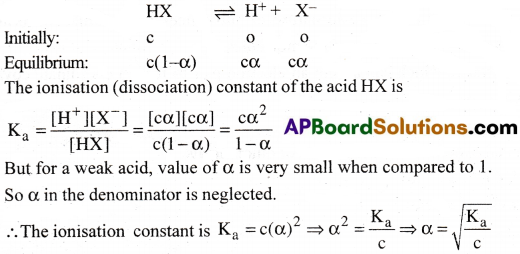
Question 13.
Define pH. What is buffer solution? Derive Henderson-Hasselbalch equation for calculating the pH of an acid buffer solution.
Answer:
The pH of a solution is defined as, the negative value of the logarithm to base 10 of hydrogen ion concentration, expressed in moles/litre in a solution.
Mathematically, pH = -log10[H+] = log10 \(\frac{1}{[H^+]}\)
Buffer solution :
A solution which can resist the change in pH, on dilution or on addition of small amount of acid or base is called Buffer solution.
Acid Buffer solution :
An acid buffer consists of a weak acid (HA) and its salt with a strong base (A–).
Derivation of Henderson-Hasselbalch equation:
The equilibrium equation of acid buffer solution:

This is called Henderson’s equation.
Since most of the conjugate base [A–] comes from the ionisation of salt of the acid,
we have pH = pKa + log\(\frac{[Salt]}{[Acid]}\)
![]()
Question 14.
Explain the term “Hydrolysis of salts” with examples. Discuss the pH of the following types of salt solutions. [TS 16]
i) Saits of weak acid and strong base
ii)Salts of strong acid and weak base.
Answer:
Salt Hydrolysis :
The reaction of a salt with water to form an acid and a base is called Salt hydrolysis. Hydrolysis of salts is the reverse process of neutralisation.
Salt + Water ⇌ Acid + Base
The phenomenon in which the anion or cation or both of a salt react with water producing excess of OH– ions or H+ ions or both in an aqueous solution is called salt hydrolysis. Salt hydrolysis may be cationic hydrolysis or anionic hydrolysis.
Cationic hydrolysis :
The cation in a salt reacts with water to give excess H+ ions. As a result, the aqueous solution of such salt is acidic in nature. That is why, it is called cationic hydrolysis.

Anionic hydrolysis :
The anion in a salt reacts with water to give excess OH– ions. As a result, the aqueous solution of such salt is basic in nature. That is why, it is called anionic hydrolysis.

Types of Salt and their hydrolysis:
i) Salts of weak acid and strong base: CH3COONa, Na2CO3, NaCN etc.
The anion of these salts undergo hydrolysis.
Ex: CH3COONa
Sodium acetate is a salt of weak acid(CH3COOH) and strong base(NaOH).
In aqueous solution, the acetate ions undergo hydrolysis resulting basic solution.
CH3COO– + H2O ⇌ CH3COOH + OH–
Here, [OH–] >[H+] ⇒ [OH–] > 1.0 × 10-7 moles/lit ⇒ pH > 7. So the solution is basic.
ii) Salts of strong acid and weak base: NH4Cl, CuSO4, FeSO4, FeCl3 etc.
The cations of these, salts undergo hydrolysis.
Ex: NH4Cl NH4CI ⇌ NH4+ + CI–
H2O ⇌ H+ + OH–
NH4Cl is a salt of strong acid(HCl) and weak base(NH4OH).
In aqueous solution, the ammonium ions undergo hydrolysis resulting an acidic solution.
NH4++ H2O ⇌ NH4OH + H+
Here, [H+] > [OH–] ⇒ [H+] > 1.0 × 10-7 moles/lit ⇒ pH < 7. So the solution is acidic.
Question 15.
What is solubility product? Explain the common ion effect on solubility of ionic salts.
Answer:
Solubility product(Ksp):
The product of concentration of cation and anion of a salt present in a saturated aqueous solution is called Solubility product.
Units: (Mol/L)n
Where n = Total number of ions that can be given by salt per molecule on ionization.
Factors effecting Ksp:
a) nature of substance b) temperature
Significance :
Solubility product is very important in preferential precipitation process of quantitative analysis.
The solubility’ of an electrolyte in water decreases by the addition of another electrolyte which has one ion common with the electrolyte.
For example, the solubility of NaCl decreases on the addition of HCl to the solution of NaCl in water. This is known as salting out of water.
Common ion effect :
The solubility of an electrolyte (acid, base, salt) in water decreases by the addition of another electrolyte (acid, base, salt) which has one ion (cation or anion) common with electrolyte. This is known as common ion effect.
Ex: Acetic acid is weak acid and it undergoes partial ionization as follows.
CH3COOH ⇌ CH3COO– + H+
In case of such electrolytes there exists an equilibrium in between ions and molecular form. In such a condition, the addition of electrolyte with common ions shifts the equilibrium in backward direction which causes the decrease in solubility.
Significance:
- Common ion effect is an important phenomenon in quantitative analysis.
- The common ion effect principle is also used in controlling the concentration of H+ions in buffer solution.
Question 16.
Write notes on
i) Common ion effect.
ii) The relation between Ksp and solubility (S) of a sparingly soluble salt BaSO4.
Answer:
Common ion effect :
The solubility of an electrolyte (acid, base, salt) in water decreases by the addition of another electrolyte (acid, base, salt) which has one ion (cation or anion) common with electrolyte. This is known as common ion effect.
Ex: Acetic acid is weak acid and it undergoes partial ionization as follows.
CH3COOH ⇌ CH3COO– + H+
In case of such electrolytes there exists an equilibrium in between ions and molecular lorm. In such a condition, the addition of electrolyte with common ions shifts the equilibrium in backward direction which causes the decrease in solubility.
Significance:
- Common ion effect is an important phenomenon in quantitative analysis.
- The common ion effect principle is also used in controlling the concentration of H+ions in buffer solution.
ii) The relation between and solubility (S) Of a sparingly soluble salt BaSO4:
The sparing soluble salt like BaSO4, when added to water form saturated solution There exists an equilibrium between undissolved solid and the ions in saturated solution.

Multiple Choice Questions
Question 1.
1 mole of PCl5 is heated in a closed Vessel of 1 litre capacity. At equilibrium 0.4 moles of chlorine is found. Calculate the equilibrium constant.
1) 0.257
2) 0.276
3) 0.286
4) 0.267
Answer:
4) 0.267
Solution:
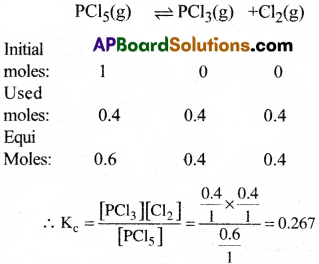
Question 2.
Nitrogen dioxide forms dinitrogen tetroxide according to the equation. 2NO2(g) ⇌ N2O4(g) when 0.1 mole of NO2 is added to a 1 litre flask at 25°C, the concentration changes so that at equilibrium [NO2] = 0.016M and [N2O4] = 0.042M.
a. What is the value of the reaction quotient before any reaction occurs.
b. What is the value of the equilibrium constant for the reaction.
1) 0,1.61 × 10²
2) 0,1.64 × 10²
3) 0,1.62 × 10²
4) 0,1.63 × 10²
Answer:
2) 0,1.64 × 10²
Solution :
(a) The value of reaction quotient before any reaction occur is zero.
(b) Given reaction: 2NO2(g) ⇌ N2O4(g)

Question 3.
The equilibrium constant for the reaction: N2(g) + 3H2(g) ⇌ 2NH3(g) at 725K is 6.0 × 10-2. At equilibrium, [H2] = 0.25 molL-1 and [NH3] = 0.06molL-1. Calculate the equilibrium concentration of N2.
1) 3.84 mole L-1
2) 3.74 mole L-1
3) 3.64 mole L-1
4) 3.54 mole L-1
Answer:
1) 3.84 mole L-1
Solution :
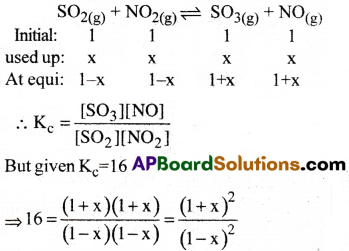
![]()
Question 4.
At certain temperature, Kc for the reaction SO2(g) + NO2(g) ⇌ SO3(g) + NO(g) is 16. If initially one mole each of all the four gases are taken in one vessel. What are the equilibrium concentrations of NO and NO2.
1) 15 mol/L, 0.3 mol/L
2) 1.6 mol/L, 0.4 mol/L
3) 1.4 mol/L, 0.2 mol/L
4) 1.3 mol/L, 0.1 mol/L
Answer:
2) 1.6 mol/L, 0.4 mol/L
Solution :

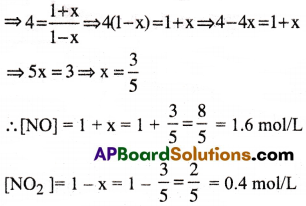
Question 5.
Under certain conditions, the equilibrium, constant for the decomposition of PCl5(g) into PCl3(g) and Cl2(g) is 0.0211 mol L-1. What are the equilibrium concentrations of PCl5, PCl3 and Cl2, if the initial concentration of PCl5 was LOOM?
1) 0.685, 0.153, 0.135
2) 0.885, 0.135, 0.135
3) 0.865, 0.135, 0.135
4) 0.865, 0.125, 0.133
Answer:
3) 0.865, 0.135, 0.135
Solution :
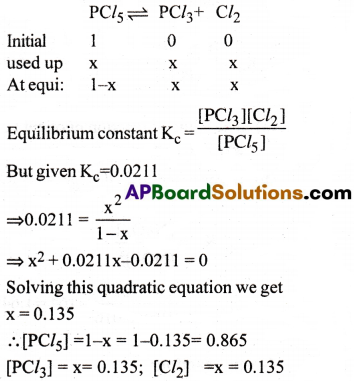
Question 6.
For the reaction A + B ⇌ 3C at 25°C, a 3 litre vessel contains 1, 2, 4 mole of A, B and C respectively predict the direction of reaction if
a. Kc for the reaction is 10
b. Kc for the reaction is 15
c. Kc for the reaction is 10.66
1) forward, backward, equilibrium
2) backward, forward, equilibrium
3) backward, forward, backward
4) backward, forward, forward
Answer:
2) backward, forward, equilibrium
Solution :
a) For the reaction Kc = 10. ∴ Q > K
Hence the reaction will be in the backward direction
b) For the reaction Kc = 15 ∴ Q < K
Hence the reaction will be in the forward direction
c) For the reaction Kc = 10.66 ∴ Q = K
Hence the reaction is at equilibrium.
Question 7.
A mixture of H2, N2 and NH3 with molar concentrations 5.0 × 10-3 mol L-1, 4. 0 × 10-3 mol L-1 and 2.0 × 10-3 mol L-1 respectively was prepared and heated to 500K. The value of Kc for the reaction: 3H2(g) + N2(g) ⇌ 2 NH3(g) at this temperature is 60. Predict whether ammonia tends to form or decompose at this stage of concentration.
1) decompose
2) form
3) neutral
4) None of these
Answer:
1) decompose
Solution :
[NH3] = 2.0 × 10-3mol L-1
[N2] = 4.0 × 10-3mol L-1
[H2] = 5.0 × 10-3mol L-1
Given reaction: N2(g) + 3H2(g) ⇌ 2NH3(g)

The given value of Kc = 60
∴ Qc > Kc. Hence the the reaction will be in backward direction and hence ammonia tends to decompose.
Question 8.
At 5000K, Kp value for the reaction
2SO2(g) + O2(g) ⇌ 2SO3(g) is 2.5 × 1010.
Find the value of Kp for each of following reactions at the same temperature.
a. SO2(g) + 1/2O2 (g) ⇌ SO3(g)
b. SO3(g) ⇌ SO2(g) + 1/2O2(g)
c. 3SO2(g) + 3/2O2(g) ⇌ 3SO3(g)
1) 1.48 × 105, 6.3 × 106, 3.95 × 1015
2) 1.48 × 105, 6.2 × 106, 3.59 × 1015
3) 1.58 × 105, 6.3 × 106, 3.95 × 1015
4) 1.58 × 105, 6.2 × 106, 3.59 × 1015
Answer:
3) 1.58 × 105, 6.3 × 106, 3.95 × 1015
Solution :

Question 9.
Kc for the reaction N2O4(g) ⇌ 2NO2(g) is 4.63 × 10-3 at 25°C.
a) What is the value of Kp at this temperature.
b) At 25°C, if the partial pressure of N2O4(g) at equilibrium is 0.2atm. Calculate equilibrium pressure of NO2(g)
1) 0.1132 atm, 0.15 atm
2) 0.1122 atm, 0.15 atm
3) 0.1132 atm, 0.11 atm
4) 0.1123 atm, 0.15 atm
Answer:
1) 0.1132 atm, 0.15 atm
Solution :
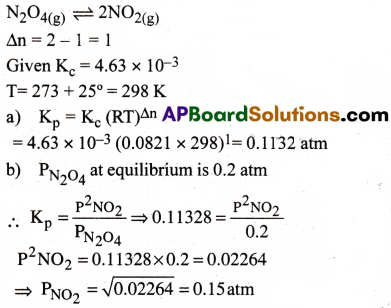
![]()
Question 10.
At 27°C, Kp value for the reversible reaction PCl5(g) ⇌ PCl3(g) + Cl2(g) Calculate Kc.
1) 0.0367 mol/L
2) 0.0463 mol/L
3) 0.0264 mol/L
4)0.0162 mol/L
Answer:
3) 0.0264 mol/L
Solution :
Kp = 0.65; R = 0.0821 lit. atm. moL-1. K-1;
T = 27 + 273 = 300K
PCl5(g) ⇌ PCl3(g) +Cl2(g)
⇒ ∆n – nP – nR = 2 – 1 = 1
Kp = Kc(RT)∆n
⇒ 0.65 = Kc (0.0821 × 300)¹
⇒ Kc = \(\frac{0.65}{0.0821\times300}\) = 0.0264 mol/L
Question 11.
Kc for the reaction N2(g) + 3H2(g) ⇌ 2NH3(g) is 0.5 at 400K, find Kp.
1) 4.63 × 10-4
2) 5.64 × 10-4
3) 6.65 × 10-4
4) 7.66 × 10-4
Answer:
1) 4.63 × 10-4
Solution :
N2(g) + 3H2(g) ⇌ 2NH3(g)
Given kc = 0.5, T = 400K, ∆n = 2 – 4 = -2
Kp = kc(RT)∆n
= 0.5 × (0.0821 × 400)-2;
= 0.5 × (8.21 × 4)-2 = 0.5 × (32.84)-2
= \(\frac{0.5}{1078.46}\) = 4.63 × 10-4
Question 12.
1 mole of A and 1 mole of B are taken in a 5 litre flask, 0.5 mole of C is formed in the equilibrium of. A + B ⇌ C + D
What is molar concentration of each species if the reaction is carried with 2 mole of A 1 mole of B in a 5 litre flask at the same temperature.
1) 0.266 mol/ L, 0.066 mol/L, 0.134 mol/L 0.134 mol/L
2) 0.265 mol/ L, 0.066 mol/L, 0.134 mol/L 0.124 mol/L
3) 0.266 mol/ L, 0.006 mol/L, 0.134 mol/L 0.134 mol/L
4) 0.266 mol/L, 0.066 mol/L, 0.124 mol/L 0.134 mol/L
Answer:
1) 0.266 mol/ L, 0.066 mol/L, 0.134 mol/L 0.134 mol/L
Solution :
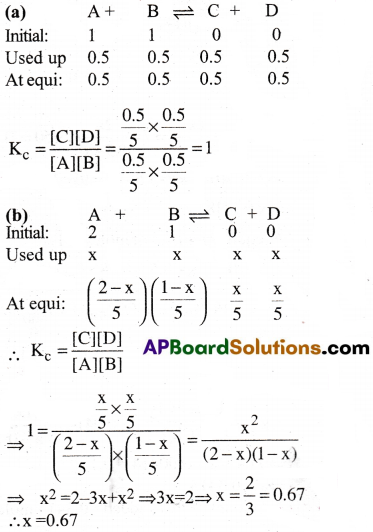

Question 13.
For the following reaction
PCl5(g) ⇌ PCl3(g) + Cl2(g) 0.4 mol of PCl5, 0.2 mole of PCl3 and 0.6 mole of Cl2 are taken in a 1 litre flask, if Kc = 0.2. Predict the direction in which reaction proceeds.
1) forward
2) backward
3) neutral
4) None
Answer:
2) backward
Solution :

Question 14.
In an equilibrium A + B ⇌ C + D ; A and B are mixed in a vessel at temperature T. The initial concentration of A was twice the initial concentration of B. After the attainment of equilibrium concentration of C was thrice concentration of B. Calculate Kc.
1) 1.6
2) 1.7
3) 1.8
4) 1.9
Answer:
3) 1.8
Solution :

![]()
Question 15.
A mixture of SO2, SO3, and Oc, gases are maintained at equilibrium in 10 litre flask at a temperature at which Kc for the reaction 2SO2(g) + O2(g) ⇌ 2SO3(g) is 100. At equilibrium.
a) If no. of moles of SO3 and SO2 in flask are same, how many moles of O2, are present.
b) If no. of moles of SO3, in flask is twice the no.of moles of SO2, how many moles of O2, are present.
1) 0.1 mole, 0.4 mole
2) 0.2 mole, 0.4 mole
3) 0.3 mole, 0.6 mole
4) 0.1 mole, 0.5 mole
Answer:
1) 0.1 mole, 0.4 mole
Solution :

Question 16.
For A + B ⇌ C, the. equilibrium concentrations of A and B at a temperature are 15 mol L-1. When volume is doubled the reaction has equilibrium concentration of A as 10 molL-1. Calculate a) Kc b) Concentration of C in original equilibrium.
1) 0.1
2) 0.2
3) 0.3
4) 0.4
Answer:
2) 0.2
Solution :
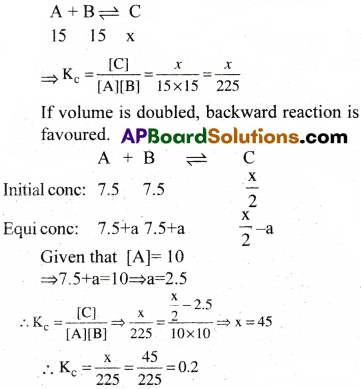
Question 17.
A vessel at 100 K contains CO2 with a pressure of 0.5 atm. Some of the CO2 is converted into CO on addition of graphite. Calculate the value of K, if total pressure of equilibrium is 0.8 atm.
1) 1.6 atm
2) 1.7 atm
3) 1.8 atm
4) 1.9 atm
Answer:
3) 1.8 atm
Solution :
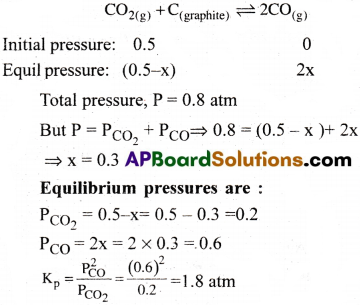
Question 18.
The Kp value for the rieaytion H2(g) + I2(g) ⇌ 2HI(g) at 460°C is 49. If the initial pressure of H2 and I2 are 0.5atm respectively, determine the partial pressure of each gases at equilibrium.
1) 0.112 atm, 0.111 atm, 0.788 atm
2) 0.110 atm, 0.110 atm, 0.778 atm
3) 0.111 atm, 0.111 atm, 0.778 atm
4) 0.112 atm, 0.112 atm, 0.778 atm
Answer:
4) 0.112 atm, 0.112 atm, 0.778 atm
Solution :
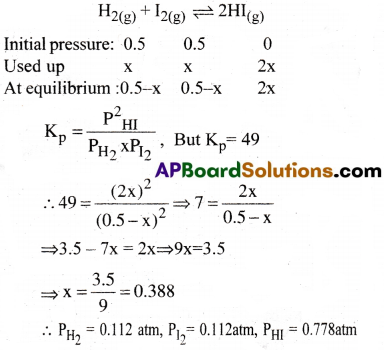
Question 19.
0.5 mol of H2 and 0.5 mole of I2 react in 10 litre flask at 448°C. The equilibrium constant Kc is 50 for H2(g) + I2(g) ⇌ 2HI(g)
a) What is the value of Kp.
b) Calculate the mole of I2 at equilibrium.
1) 50,0.001
2) 50,0.111
3) 50,0.101
4) 50,0.119
Answer:
2) 50,0.111
Solution :
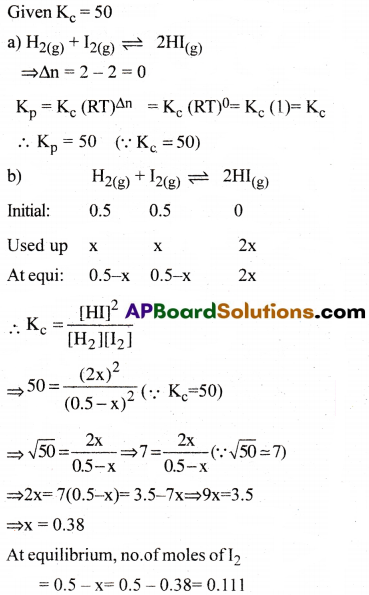
Question 20.
How much PCl5 must be added to a one little vessel at 250°C in order to obtain a concentration of 0.1 mole of Cl2 at equilibrium. Kc for PCl5(g) ⇌ PCl3(g) + Cl2(R) is 0.0414M.
1) 0.3215 moles
2) 0.3425 moles
3) 0.3446 moles
4) 0.3415 moles
Answer:
4) 0.3415 moles
Solution :
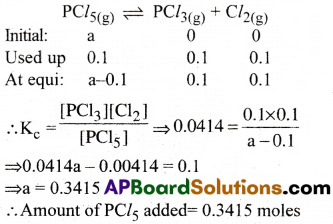
Question 21.
Kp for the reaction N2(g) + 3H2(g) ⇌ 2NH3(g) at 400°C is 1.64 × 10-4. a) Calculate the Kc b) Calculate ∆G° value using Kc value.
1) 0.4006, 3872.25 J
2) 0.5006, 3872.25 J
3) 0.5006, 3822.25 J
4) 0.5506, 3872.25 J
Answer:
2) 0.5006, 3872.25 J
Solution :
a) N2(g) + 3H2(g) ⇌ 2NH3(g)
∆n = nP – nR = 2 – 4 = -2
R = 0.0821 lit. atm. mol-1 .K-1
T = 400+ 273 = 673 K .
Kp = 1.64 v 10-4
Now Kp = Kc (RT)∆n
⇒ 1.64 × 10-4 = Kc (0.0821 × 673)-2
⇒ Kc = 1.64 × 10-4 (0.0821 × 673)² = 0.5006
b) ∆G° = – 2.303 RT log Kc
= – 2.303 × 8.314 × 673 log (0.5006)
= 3872.251
![]()
Question 22.
Calculate the pH of [TS 15]
(a) 10-3 M HCl
(b) 10-3 M H2SO4
(c) 10-6 M HNOa
(d) 0.02 M H2SO4
1) 3, 2.699, 6, 1.3979
2) 3, 2.999, 6, 1.3679
3) 3, 2.669, 6, 1.3679
4) 3, 2.589, 6, 1.3979
Answer:
1) 3, 2.699, 6, 1.3979
Solution :
a) HCl is a strong and monobasic acid.
∴ [H+] = Molarity × Basicity
= 10-3 × 1 = 10-3
∴ pH = -log10[H+]
= log1010-3 = – (-3) log1010 = 3
b) H2SO4 is a strong and dibasic acid.
N = m × n = 10-3 × 2
∴ pH = -log[H+] = -log(2 × 10-3)
= 3-log2 = 3 – 0.3010 = 2.699
c) HNO3 is a strong and monobasic acid.
∴ [H+] = Molarity x Basicity
= 10-6 × 1 =10-6
∴ pH =-log10[H+]
= -log1010-6 = -(-6) log1010 = 6
b) H2SO4 is a strong and dibasic acid.
∴ [H+] = Molarity × Basicity
= 0.02 × 2 = 4 × 10-2
∴ pH = -log[H+] = -log10(4 × 10-2)
= -log 104-log 10-2
= -0.6021 – (-2)log1010
= 2 – 0.6021 = 1.3979
Question 23.
Calculate of pH for
(a) 0.001 M NaOH
(b) 0.01 M Ca(GH)2
(c) 0.0008 M Ba(OH)2
(d) 0.004M NaOH
1) 11, 12.3010, 11.1041, 11.5021
2) 11, 12.3000, 11.2041, 11.6021
3) 11, 12.3010, 11.2041, 11.6021
4) 11, 12.3000, 11.2241, 11.0021
Answer:
3) 11, 12.3010, 11.2041, 11.6021
Solution :
a) NaOH is a strong and monoacidic base.
∴ [OH–] = Molarity × Acidity
= 0.001 × 1 = 10-3
∴ pOH = -log10[OH–]
= – log 1010-3 = -(-3) log1010 = 3
But, pH + pOH = 14
∴ pH = 14 – pOH = 14 – 3 = 11
b) Ca(OH)2 is a strong and diacidic base.
∴ [OH–] = Molarity × Acidity
= 0.01 × 2 = 2 × 10-2
∴ pOH = -log10[OH–]
= -log10(2 × 10-2)
= -log102 – log1010-2
= -0.3010 – (-2) log1010
= 2 – 0.3010 = 1.6990
∴ pH = 14 – pOH = 14 – 1.6990 = 12.3010
c) Ba(OH)2 is a strong and diacidic base.
∴ [OH–] = Molarity × Acidity
= 0.0008 × 2 = 16 × 10-4
∴ pOH = -log10[OH–]
= -log10(16 × 10-4)
= -log1016- log1010-4
= -1.2041 – (-4) log 10
= 4 – 1.2041 = 2.7959
pH = 14 – pOH = 14 – 2.7959 = 11.2041
d) NaOH is a strong and monoacidic base.
∴ [OH–]= Molarity × Acidity
= 0.004 × 1 = 4 × 10-3
pOH = -log10[OH–]
= -log10(4 × 10-3)
= – log104 – log1010-3
= -0.6021 – (-3)log1010
= 3-0.6021 = 2.3979
∴ pH = 14 – pOH =14- 2.3979 = 11.6021
Question 24.
The pH of a solution is 3.6. Calculate H3O+ ion concentration.
1) 2.532 × 10-4
2) 2.512 × 10-4
3) 2.522 × 10-4
4) 2.555 × 10-4
Answer:
2) 2.512 × 10-4
Solution :
Given pH = 3.6
⇒ pH= -log[H+]
⇒ log[H+]= -pH = 3.6 = -3 – 0.6 + 1 – 1 = 4.4
∴ [H3O+] = [H+] = Anti log of [4.4]
= Anti log of 0.4 × 10-4 = 2.512 × 10-4
Question 25.
The pH of a solution is 8.6. Calculate OH– ion concentration. .
1) 3.961 × 10-6 moles/L
2) 3.971 × 10-6 moles/L
3) 3.991 × 10-6 moles/L
4) 3.981 × 10-6 moles/L
Answer:
4) 3.981 × 10-6 moles/L
Solution :

Question 26.
What is [H+] for a solution in which
a) pH = 3 b) pH = 4.75 c) pH = 4.4
1) 10-5M, 1.778 × 10-5M, 3.981 × 10-5M
2) 10-5M, 1.777 × 10-5M, 3.981 × 10-5M
3) 10-5M, 1.778 × 10-5M, 3.991 × 10-5M
4) 10-5M, 1.778 × 10-5M, 3.881 × 10-5M
Answer:
2) 10-5M, 1.777 × 10-5M, 3.981 × 10-5M
Solution :
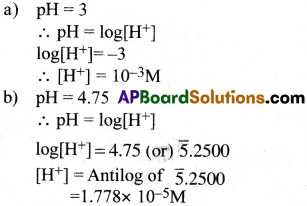

Question 27.
A solution of 0.005M H2S04 is diluted 100 times. Calculate the pH of diluted solution?
1) 2
2) 16
3) 4
4) 8
Answer:
3) 4
Solution :
Given that [H+] = 0.005 × 2 = 0.01
After 100 times dilution
[H+] = 10-4
[H+] = \(\frac{0.01}{100}\) = 0.0001
pH = -log[H+] = -log 0.0001 = -log10-4 = 4
![]()
Question 28.
A solution of HCl has a pH = 3, If one ml of it is diluted to 1 litre, what will be the pH of the resulting solution?
1) 1
2) 3
3) 5
4) 6
Answer:
4) 6
Solution :
Given pH = 3 for HCl solution
∴ [H+] = 10-3 M
1 ml is diluted to 1 litre
∴ [H+] = \(\frac{10^{-3}}{10^3}\) = 10-6
∴ pH = -log[H+] = -log[10-6] = 6
Question 29.
Find the pH the 10-8 M HCl solution,
1) 6.9486
2) 6.9586
3) 6.9686
4) 6.9786
Answer:
2) 6.9586
Solution :
Formula : pH = -log[H+] [TS 15]
The given acid solution is very dilute. Hence H+ ion obtained from the acid and water must be taken into consideration.
H+ ion concentration of acid is 10-8M
H+ ion concentration of water is 10-7M
Total [H+] = [H+] from acid + [H+] from water
= 10-8 + 10-7
= 0.1 × 10-7 M+ 1 × 10-7M
= 1.1 × 10-7 M
∴ pH = -log[1.1 × 10-7]
= -(0.0414-7) = 6.9586.
Question 30.
Calculate the pH of the following basic solutions. [AP 18]
(a) [OH–] = 0.05M
(b) [OH–] = 2 × 10-4M
1) 12.999, 10.3010
2) 12.699, 11.3010
3) 12.699, 10.2110
4) 12.699, 10.3010
Answer:
4) 12.699, 10.3010
Solution :
(a) [OH–] = 0.05M
pOH = -log(0.05)= -log 5 × 10-2
= -log5 + 2log10
= 2 – log 5 = 1.3010
pOH = 1.3010
pH = 14 -pOH = 14 -1.3010= 12.699
(b) [OH–] = 2 × 10-4M
pOH = -log 2 × 10-4
= -log2 + log10
= 4 – log 2 = 4 – 0.3010 = 3.699
pOH = 14 – 3.699 = 10.3010.
Question 31.
2g of NaOH is dissolved in water to give 1 litre solution. What is the pH of the solution?
1) 12.6990
2) 12.9990
3) 12.6660
4) 12.8880
Answer:
1) 12.6990
Solution :

Question 32.
Calculate the pH of the following solutions.
a) 0.37g of Ca(OH)2 dissolved in water to give 500ml solution.
b) 0.3g of NaOH dissolved in water to give 200ml solution.
c) 0.1825% HCl aqueous solution.
d) 1ml of 13.61VI HCl is diluted with water to give 1 litre solution.
1) 12.3000, 12.564, 1.308, 1.87
2) 12.3010, 12.574, 1.308, 1.95
3) 12.3010, 12.574, 1.308, 1.87
4) 12.3310, 12.564, 1.208, 1.87
Answer:
3) 12.3010, 12.574, 1.308, 1.87
Solution :
[H+] = 0.05N
∴ pH =-log[H+] = -log[0.05]
= -log[ 5 × 10-2]
= 2 – log 5 = 2 – 0.692 =1.308
∴ pH = 1.308
d) [H+] = 13.6
1 ml is diluted with water in to 1 litre solution
∴ [H+] = \(\frac{13.6}{1000}\) = 0.0136
pH= -log[H+] = -log[0.0136] = 1.87
Question 33.
How many grams of NaOH are present in 100ml solution if pH of the solution is 10?
1) 4 × 10-4
2) 5 × 10-4
3) 4 × 10-2
4) 5 × 10-2
Answer:
1) 4 × 10-4
Solution :
Given pH = 10
pOH= 14 – 10 = 4
N = 10-4

Question 34.
The value of Kw is 9.55 × 10-14 at certain temperature. Calculate the pH of water at this temperature.
1) 6.56
2) 6.51
3) 6.55
4) 6.54
Answer:
2) 6.51
Solution :

pH = -log(3.09 × 10-7)
= -[log3.09 + log 10-7] = -[0.49 – 7]
= 7 – 0.49 = 6.51
![]()
Question 35.
Calculate the pH of 10-8M NaOH.
1) 7.0314
2) 7.0419
3) 7.0444
4) 7.0414
Answer:
4) 7.0414
Solution :
Base is very dilute. So OH– concentration in water must be taken into consideration
∴ Total [OH–]
= [OH–] from base + [OH–] from water
= 10-8 + 10-7 = 1.1 × 10-7
pOH = log10[OH–] = log10 1.1 × 10-7
= 7 – 0.0414 = 6.9586
∴ pH = 14 – pOH= 14 – 6.9586 = 7.0414
Question 36.
150 ml of 0.5 M HCI and 100 ml of 0.2M HCI are mixed. Find the pH of the resulting solution.
1) 0.4202
2) 0.4222
3) 0.4002
4) 0.2202
Answer:
1) 0.4202
Solution :

Question 37.
Calculate the pH of solution obtained by mixing 10ml of 0.1M HCl and 40ml of 0.21M H2SO4.
1) 0.4666
2) 0.4886
3) 0.4686
4) 0.4888
Answer:
3) 0.4686
Solution :
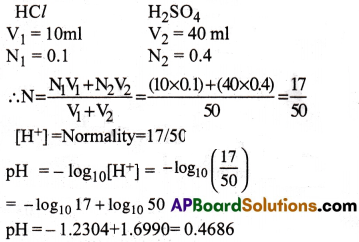
Question 38.
100ml of pH = 4 solution is mixed with 100ml of pH = 6 solution. What is the pH of resulting solution.
1) 4.2999
2) 4.2967
3) 4.2667
4) 4.6467
Answer:
2) 4.2967
Solution :
V1 = Volume of first solution = 100ml
N1 = Proton concn.of 1st solution = 10-pH = 10-4M
V2 = Volume of second solution = 100ml
N2 = Proton concn.of 2nd solution = 10-pH = 10-6M
Proton concentration of mixed solution is

pH = -log10[H+] = -log10(5.05 × 10-5)
= 5 – log5.05 = 5 – 0.7033 = 4.2967
Tip : If equal volumes of two same solutions whose pH values are less than 7, then Final
pH = lower pH + 0.3 = 4 + 0.3 = 4.3
Question 39.
Equal volumes of 0.5 M NaOH and 0.3M KOH are mixed in an experiment. Find the pOH and pH of the resulting solution.
1) 0.3999, 13.5021
2) 0.3979, 13.6021
3) 0.3969, 13.6121
4) 0.3979, 13.5021
Answer:
2) 0.3979, 13.6021
Solution :
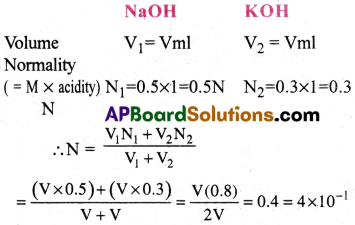
∴ [OH–] = N = 4 × 10-1
pOH = -log10[OH–]= -log10 (4 × 10-1)
= 1 – log10 4 – log10 10-1
= 1 – log.4 = 1 – 0.6021 = 0.3979
pH = 14 – pOH = 14 – 0.3979 = 13.6021
Question 40.
60ml of 1M HCl is mixed with 40ml of 1M NaOH. What is the pH of resultant solutions?
1) 0.6660
2) 0.5890
3) 0.6990
4) 0.5770
Answer:
3) 0.6990
Solution :
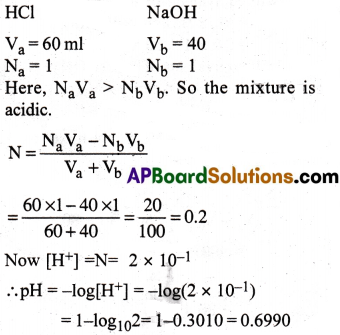
Now [H+] = N = 2 × 10-1
∴ pH = -log[H+] = -log(2 × 10-1)
= 1 – log102 = 1 – 0.3010 = 0.6990
Question 41.
Calculation the pH of a solution which contains 100ml of 0.1 M HCI and 9.9ml of 1.0M NaOH.
1) 3.0016
2) 3.0416
3) 3.0146
4) 3.0616
Answer:
2) 3.0416
Solution :

Question 42.
What will be the resultant pH when 200ml of an aqueous solution of HCl having PH = 2 is mixed with 300ml of an aqueous solution of NaOH having pH = 12?
1) 11.3666
2) 11.3118
3) 11.3777
4) 11.3010
Answer:
4) 11.3010
Solution :

[OH+] = 2 × 10-3
∴ pOH = -log(2 × 10-3)
= 3 – log2 = 3 – 0.3010 = 2.6990
∴ pH = 14-2.6990 = 11.3010
![]()
Question 43.
43. 50 ml of 0.2 M HCI is added to 30 ml of 0.1 M KOH solution. Find the pH of the solution.
1)1.055
2) 1.085
3) 1.058
4) 1.008
Answer:
3) 1.058
Solution :
Milliequivalents of acid (HCl)= NaVa(ml)
= Ma × Basicityx Va (ml)
= 0.2 × 1 × 50 = 10
Milliequivalents of base (KOH)= NbVb (ml)
= Mb × Acidity x Vb(ml)
= 0.1 × 1 × 30 = 3
Here, NaVa > NbVb .So the mixture is acidic.
∴ N = [H+] =
Question 44.
40ml of 0.2M HNO3 when reacted with 60ml of 0.3M NaOH, gave a mixed solution. What is the pH of the resulting solution.
1) 13
2) 14
3) 15
4) 16
Answer:
3) 15
Solution :
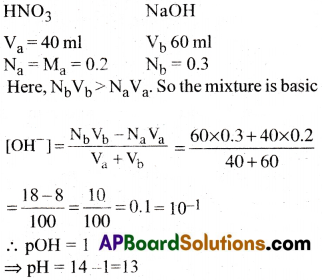
Question 45.
50ml of 0.1M H2SO4 were added to 100ml of 0.2M HNO3. Then the solution is diluted to 300ml. What is the pH of the solution.
1) 2
2) 1
3) 4
4) 3
Answer:
2) 1
Solution :
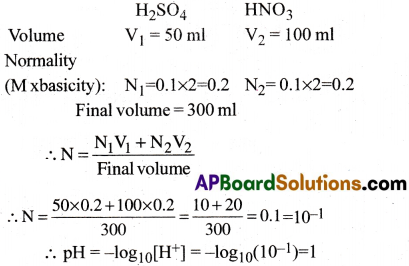
Question 46.
What is the Kw value in an a aqueous solution of pKw = 13.725
1) 1.854 × 10-4
2) 1.864 × 10-4
3) 1.874 × 10-4
4) 1.884 × 10-4
Answer:
4) 1.884 × 10-4
Solution :
Given that pKw = 13.725
pKw = -log Kw
⇒ logKw = -pKw = -13.725
⇒ Kw = anti log (14.275) = 1.884 × 10-4
Question 47.
The ionic product of water at 80°C is 2.44 × 10-13. What are the concentrations of hydronium ion and the hydroxide in pure water at 80°C?
1) 4.74 × 10-7mol/L, 4.74 × 10-7mol/L
2) 4.64 × 10-7mol/L, 4.64 × 10-7mol/L
3) 4.94 × 10-7mol/L, 4.94 × 10-7mol/L
4) 4.84 × 10-7mol/L, 4.84 × 10-7mol/L
Answer:
3) 4.94 × 10-7mol/L, 4.94 × 10-7mol/L
Solution :

Question 48.
The ionization constant for water is 2.9 × 10-14 at 40°C. Calculate [H3O+], [OH], pH and pOH for pure water at 40°C.
1) 6.7689
2) 6.7779
3) 6.7669
4) 6.9999
Answer:
1) 6.7689
Solution :
Given that Ka = 2.9 × 10-14
[H+] = \(\sqrt{\mathrm{k}_{\mathrm{a}}}=\sqrt{2.9 \times 10^{-14}}\) = 1.703 × 10-7
For pure water, [H+] = [OH–]
∴ [H+] = 1.703 × 10-7
[OH–] = 1.703 × 10-7
pH = -log[H+] = -log[1.703 × 10-7]
= 7-log 1.7= 6.7689
Hence, pOH = 6.7689
![]()
Question 49.
Calculate the pH of
a) 0.002 M aceticacid having 2.3% dissociation.
b) 0.002M NH4OH having 2.3%; dissociation.
1) 4.3999, 9.998
2) 4.3372, 9.6628
3) 4.8765, 9.2345
4) 4.0001, 9.0123
Answer:
2) 4.3372, 9.6628
Solution :
a) c = 0.002 M = 2 × 10-3, α = 2.3%
[H+] = cα = 2 × 10-3 × \(\frac{2.3}{100}\) = 4.6 × 10-5
pH = -log[H+] = -log[4.6xlO-5]
= 5 – log 4.6= 5-0.6628 = 4.3372
b) c = 0.002M = 2 × 10-3, α = 2.3%
[OH–] = Cα
= 2 × 10-3 × \(\frac{2.3}{100}\) = 4.6 × 10-5
pOH = -log[OH–] = -log[4.6 × 10-5]
= 5-log 4.6 = 5-0.6628 = 4.3372
pOH = 4.3372
∴ pH= 14 – pOH = 14 – 4.3372 = 9.6628
Question 50.
Calculate Ka of acetic acid from equilibrium concentration given below. [H3O+]=[CH3COO–] = 1.34 × 10-3M, [CH3COOH] = 9.866 × 10-2M
1) 1.02 × 10-5
2) 1.92 × 10-5
3) 1.22 × 10-5
4) 1.82 × 10-5
Answer:
4) 1.82 × 10-5
Solution :

Question 51.
Calculate pH of 0.1M acetic acid haying Ka = 1.8 × 10-5M
1) 2.8712
2) 2.1111
3) 2.9912
4) 2.7712
Answer:
1) 2.8712
Solution :

Question 52.
The pH of 0.1M Solution of weak mono protic acid is 4.0. Calculate its [H+] and Ka.
1) 10-7
2) 10-9
3) 10-5
4) 10-8
Answer:
1) 10-7
Solution :
Given c = 0.1 M; pH = 4
a) [H+] = 10-pH = 10-4

Question 53.
Ka of 0.02M CH3COOH is 1.8 × 10-5. Calculate
a) [H3O+]
b) % ionisation
c) pH
1) 5 × 10-4, 3%, 3.2218
2) 6 × 10-4, 2%, 2.2218
3) 6 × 10-4, 3%, 3.2218
4) 5 × 10-4, 2%, 2.2218
Answer:
3) 6 × 10-4, 3%, 3.2218
Solution :
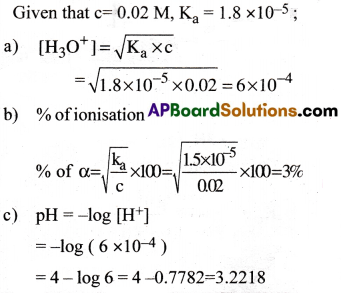
Question 54.
Calculate the pH of 0.01M solution of CH3COOH. Ka for CH3COOH at 298K is 1.8 × 10-5.
1) 3.7724
2) 3.3724
3) 3.7324
4) 3.3334
Answer:
2) 3.3724
Solution :

Question 55.
The pH of 0.1M solution of an organic acid is 4.0 calculate the dissociation constant of the acid.
1) 10-8
2) 10-9
3) 10-5
4) 10-7
Answer:
4) 10-7
Solution :
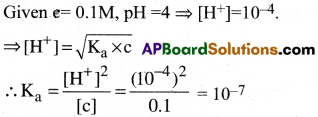
Question 56.
Three ionization constants of HF, HCOOH and HCN at 298K are 6.8 × 10-4, 1.8 × 10-4 and 4.8 × 10-9 respectively. Calculate the ionization constants of the corresponding conjugate base.
1) 1.49 × 10-11, 1.59 × 10-11, 2.09 × 10-6
2) 1.47 × 10-11, 1.66 × 10-11, 2.09 × 10-6
3) 1.47 × 10-11, 1.56 × 10-11, 2.08 × 10-6
4) 1.57 × 10-11, 1.66 × 10-11, 2.08 × 10-6
Answer:
3) 1.47 × 10-11, 1.56 × 10-11, 2.08 × 10-6
Solution :
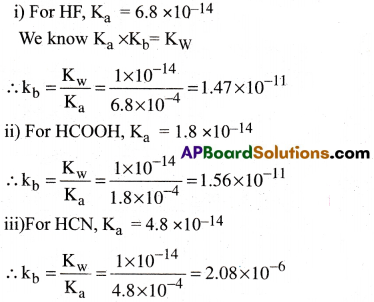
Question 57.
Find the concentration of hydroxide ion in a 0.25M solution of trimethylamine, a weak base.(eH3)3N + H2O ⇌ (CH3)3N+H+OH ; Kb = 7.4 × 10-5
1) 4.3 × 10-3M
2) 4.6 × 10-6M
3) 4.5 × 10-4M
4) 4.8 × 10-3M
Answer:
1) 4.3 × 10-3M
Solution :

Question 58.
The 0.005 M monobasic acid has a pH of 5. What is the extent of ionization?
1) 0.1%
2) 0.2%
3) 0.3%
4) 0.4%
Answer:
2) 0.2%
Solution :
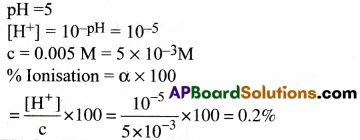
Question 59.
50 ml of 0.1M NH4OH, 25ml of 2M NH4Cl are used to make buffer. What is the pH of the solution? pKb of NH4OH is 4.8.
1) 8.2
2) 8.3
3) 8.4
4) 8.5
Answer:
1) 8.2
Solution :
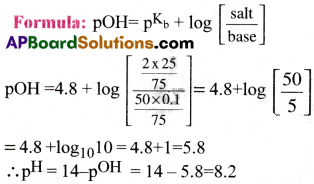
![]()
Question 60.
The pH of a buffer prepared by mixing 50ml of 0.2M CH3COOH and 25ml of CH3COONa is 4.8. If the pKa is 4.8. What is the strength of CH3COONa.
1) 0.6 M
2) 0.5 M
3) 0.4 M
4) 0.7 M
Answer:
3) 0.4 M
Solution :

Question 61.
50ml of 0.1 sodium acetate, 25ml of 0.2m acetic acid are added together to or buffer solution. pKa of acetic acid is 4.8. Find the pH of the solution.
1) 4.6
2) 4.8
3) 4.9
4) 4.2
Answer:
2) 4.8
Solution :
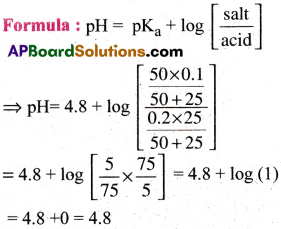
Question 62.
When 20ml of 0.1M NH4OH are added to 20ml of 1M NH3Cl solution, the pH of the buffer formed is 8.2. What is the
pKb of NH4OH?
1) 4.6
2) 4.2
3) 4.9
4) 4.8
Answer:
4) 4.8
Solution :
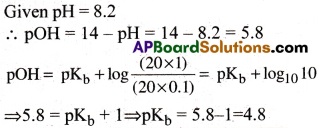
Question 63.
One litre of buffer solution contains 0.1 mole of aceticacid add 1 mole of sodium acetate. Find its pH if pKa of CH3COOH is 4.8.
1) 5.2
2) 5.4
3) 5.6
4) 5.8
Answer:
4) 5.8
Solution :
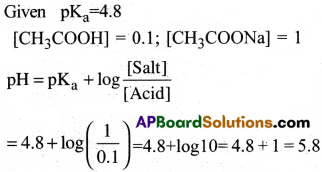
Question 64.
50ml of 1M CH3COOH solution, when added to 50ml of 0.5M NaOH gives a solution with a pH value ‘X’. Find the value of ‘X’. pKa of acetic acid is 4.8.
1) 4.6
2) 4.7
3) 4.8
4) 4.2
Answer:
3) 4.8
Solution :
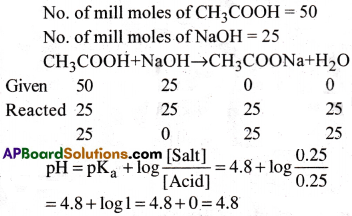
Question 65.
The solubility product of AgCl is 1.6 × 1010 moles²/lit². What is its solubility?
1) 1.26 × 10-5
2) 1.36 × 10-5
3) 1.46 × 10-5
4) 1.56 × 10-5
Answer:
1) 1.26 × 10-5
Solution :

Question 66.
The solubility product of Zr(OH)2 is 4.5 × 10-17 mol³L³. What is solubility?
1) 2.4 × 10-6
2) 2.7 × 10-6
3) 2.6 × 10-6
4) 2.9 × 10-6
Answer:
3) 2.6 × 10-6
Solution :
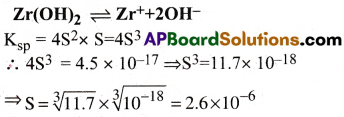
Question 67.
The solubility of Ag2CrO4 is 1.3 × 10-4 molL-1 what is the solubility product?
1) 9.52 × 10-12
2) 9.62 × 10-12
3) 9.72 × 10-12
4) 9.82 × 10-12
Answer:
2) 9.62 × 10-12
Solution :
Ag2 CrO4 ⇌ 2Ag+ + Ag2CrO42-
Ksp = 4S² × S = 4S³
∴ Ksp = 4 × S³ = 4 × (1.3 × 10-4)³ = 9.62 × 10-12
Question 68.
The solubility of A2B is 2 × 10-3 moles/ lit. What is its solubility product ?
1) 3.2 × 10-8
2) 3.3 × 10-8
3) 3.4 × 10-8
4) 3.5 × 10-8
Answer:
1) 3.2 × 10-8
Solution :
A2B ⇌ 2A+ + B-2
Ksp = [A+]²[B-2] = [2S]²[S] = 4S² × S = 4S³
= 4(2 × 10-3) = 4 × 8 × 10-9 = 32 × 10-9
= 3.2 × 10-8
![]()
Question 69.
The solubility product of a salt AB = 10-10,0mol²L-2. What is solubility?
1) 10-4
2) 10-5
3) 10-6
4) 10-7
Answer:
2) 10-5
Solution :
For AB, ksp = 10-10 mol² L-2
ksp = [A] [B] = [S]²
⇒ [S] = \(\sqrt{\mathrm{k}_{\mathrm{sp}}}=\sqrt{10^{-10}}\) = 10-5 mol.L-2
Question 70.
PQ and RS2 are two sparingly soluble salts. Their solubility products are equal and each equal to 4.0 × 10-18 Which salt is more soluble?
1) RS2
2) PQ
3) PQ & RS2
4) None of these
Answer:
1) RS2
Solution :
For PQ salt, Ksp = [P+][Q–]
If x is the solubility then 4 × 10-18 = x²
⇒ x = 2.0 × 10-9
For RS2 salt, Ksp = [R+2][S-1]²
If y is the solubility then 4 × 10-18 = 4y³
⇒ y = 1 × 10-6
Since y is more than x, solubility of RS2 salt is more.
Question 71.
In a 0.1 M Solution, acetic acid is 1.34% ionized. Calculate [H+][CH3COO–] and [CH3COOH] in the solution and calculate Ka of acetic acid.
1) 1.39 × 10-3, 1.34 × 10-3, 0.099, 1.7 × 10-5
2) 1.30 × 10-3, 1.34 × 10-3, 0.079, 1.8 × 10-5
3) 1.34 × 10-3, 1.34 × 10-3, 0.099, 1.8 × 10-5
4) 1.34 × 10-3, 1.30 × 10-3, 0.089, 1.8 × 10-5
Answer:
3) 1.34 × 10-3, 1.34 × 10-3, 0.099, 1.8 × 10-5
Solution :
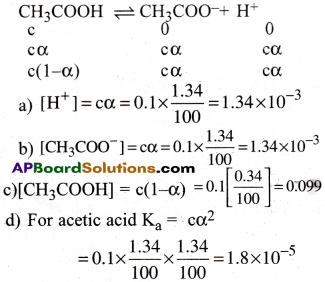
Question 72.
The following concentrations were obtained for the formation of NH3 from N2 and H2 at equilibrium at 500K.
[N2] = 1.5 × 10-2M. [H2] = 3.0 × 10-2M and [NH3] = 1.2 × 10-2M. Calculate equilibrium constant.
1) 3.54 × 10²
2) 3.55 × 10²
3) 3.56 × 10²
4) 3.57 × 10²
Answer:
2) 3.55 × 10²
Solution :


Question 73.
At equilibrium, the concentrations of N2 = 3.0 × 10-3M, O2 = 4.2 × 10-3M and NO = 2.8 × 10-3M, in a sealed vessel at 800K. What will be Kc for the reaction N2(g) + O2(g) ⇌ 2NO(g)
1) 0.422
2) 0.522
3) 0.622
4) 0.722
Answer:
3) 0.622
Solution :

Question 74.
PCl5, PCl3 and Cl2 are at equilibrium at 500 K and having concentration 1.59M PCl3, 1.59M Cl2 and 1.41 M PCl5. Calculate Kt. for the reaction
PCl5 ⇌ PCl3 + Cl2
1) 1.69
2) 1.79
3) 1.89
4) 1.99
Answer:
2) 1.79
Solution :

Question 75.
The value of KC = 4.24 at 800K for the reaction,
CO(g) + H2O(g) ⇌ CO2(g) + H2(g) Calculate equilibrium concentrations of CO2, H2, CO and H2O at 800K, if only CO and HO are present initially at concentrations of 0.10 M each.
1) 0.067 M, 0.033 M
2) 0.057 M, 0.023 M
3) 0.069 M, 0.034 M
4) 0.062 M, 0.021 M
Answer:
1) 0.067 M, 0.033 M
Solution :
Let x mole per litre of the product to be formed

⇒ x² =4.24(0.01 + x² – 0.2x)
= 0.0424 + 4.24x² – 0.848x
= 3.24x² – 0.848x+0.0424
By solving the above quadratic equation we get x = 0.067
∴ [CO2] = [H2] = x = 0.067M
[CO] = [H2O] = 0.1 – 0.067 = 0.033M
Question 76.
For the equilibrium
2NOCl(g) ⇌ 2NO(g) + Cl2(g) the value of the equilibrium constant, Kc is 3.75 × 10-6 at 1069 K. Calculate the Kp for the reaction at this temperature.
1) 3.33 × 10-4
2) 3.36 × 10-4
3) 3.36 × 10-9
4) 3.33 × 10-8
Answer:
1) 3.33 × 10-4
Solution :
The given reaction:
2NOCl(g) ⇌ 2NO(g) + Cl2(g)
⇒ ∆n = (2 + 1) – 2 = 1
Now , Kp = Kc (RT)∆n
= 3.75 × 10-6 (0.0821 × 1069)
= 333.12 × 10-6 = 3.33 × 10-4
![]()
Question 77.
The value of Kp for-the reaction. CO2(g) + C(s) ⇌ 2C0(g) is 3.0 at 1000 K. If initially PCO2 = 0-48 bar and PCO = 0 bar and pure graphite is present, calculate the equilibrium partial pressures of CO and CO2.
1) 0.99, 0.14
2) 0.44, 0.12
3) 0.66, 0.15
4)0.56, 0.15
Answer:
3) 0.66, 0.15
Solution :
Let ‘x’ be the decrease in pressure of CO2
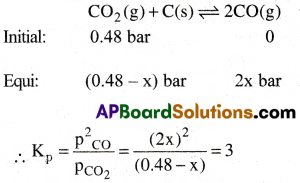
⇒ 4x² = 3(0.48 – x) ⇒ 4x² = 1.44 – x
⇒ 4x² + 3x – 1.44 = 0
Solving this quadratic equation,
we get x = 0.33
The equilibrium partial pressures are,
pCO = 2x = 2 × 0.33 = 0.66 bar
pCO2 = 0.48 – x = 0.48 – 0.33 = 0.15 bar
Question 78.
The value of Kc for the reaction 2A ⇌ B + C is 2 × 10-3. At a given time the composition of reaction mixture is [A] = [B] = [C] = 3 × 10-4 M, In which direction the reaction will proceed?
1) forward
2) reverse
3) neutral
4) None of these
Answer:
2) reverse
Solution :
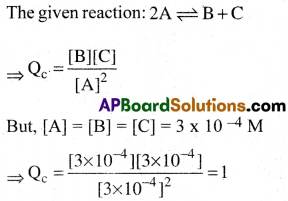
It is given that, Kc = 2 × 10-3
∴ Qc > Kc.
Hence, the reaction will proceed in the reverse direction.
Question 79.
13.8g of N2O4 was placed in a 1L reaction vessel at 400K and allowed to attain equilibrium N2O4g) ⇌ 2NO2(g). The total pressure at equilibrium was found to be 9,15 bar. Calculate Kc, Kp and parital pressure at equilibrium.
1) 2.9, 88.87
2) 2.7, 86.87
3) 2.6, 85.87
4) 2.3, 89.87
Answer:
3) 2.6, 85.87
Solution :
We know pV = nRT
Total volume (V) = 1L
Molecular mass of NO = 92g
Number of moles (n) = \(\frac{13.8}{92}\) = 0.15
Gas constant(R) = 0.083 bar L mol-1 L-1
Temperature (T) = 400K
Now pV = nRT
⇒ p × 1L = 0.15 × 0.083 × 400 = 4.98
The given reaction:
N2O4(g) ⇌ 2NO2(g)
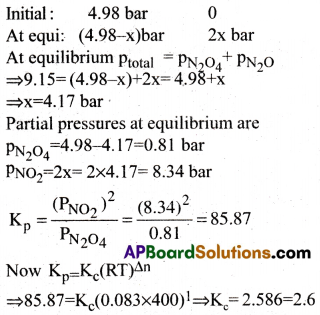
Question 80.
3.00 mol of PCl5 kept in 1 L closed reaction vessel was allowed to attain equilibrium at 380 K. Calculate composition of the mixture at equilibrium Kc = 1.80.
1) 1.41, 1.59
2) 1.42, 1.57
3) 1.43, 1.58
4) 1.44, 1.56
Answer:
1) 1.41, 1.59
Solution :
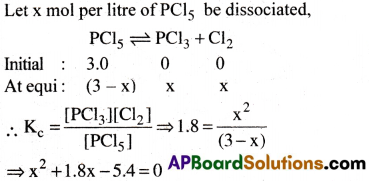
Solving this quadratic equation, we get x = 1.59
∴ [PCl5] = 3.0 – x = 3 – 1.59 = 1.41 M
[PCl3] = [Cl2] = x = 1.59 M
Question 81.
The value of ∆G° for the phosphorylation of glucose in glycolysis is 13.8 KJ/mol. Find the value of Kc at 298K.
1) 3.51 × 10-3
2) 3.81 × 10-3
3) 3.61 × 10-3
4) 3.91 × 10-3
Answer:
2) 3.81 × 10-3
Solution :
∆G°= 13.8 KJ/mol = 13.8 × 10-3 J/mol
Also ∆G° = – RT In Kc
∴ In Kc = – 13.8 × 10³ / (8.314 × 298 K) = -5.569
⇒ Kc = e-5.569 = 3.81 × 10-3
Question 82.
Hydrolysis of sucrose gives,
Sucrose + H2O ⇌ Glucose + Fructose
Equilibrium constant Kc for the reaction is 2 × 1013 at 300 K. Calculate ∆G° at 300K.
1) -7.64 × 104
2) -7.44 × 104
3) -7.54 × 104
4) -7.67 × 104
Answer:
1) -7.64 × 104
Solution :
Formula: ∆G° = – RT In Kc
∴ ∆G°= -8.314 × 300 xln(2 × 1013)
= -7.64 × 104 J/mol-1
![]()
Question 83.
What will be the conjugate bases for the following Bronsted acids:
HF, H2SO4, HCO–3
1) F–, HSO–4, CO4-2
2) F–, HSO–2, CO2-3
3) F, HSO–2, CO4-3
4) F–, HSO–4, CO2-3
Answer:
4) F–, HSO–4, CO2-3
Solution :
The conjugate bases should have ohe proton less in each and therefore the corresponding conjugate bases are :
F–, HSO–4 and CO2-3 respectively.
Question 84.
Write the conjugate acids for the following Bronsted bases:
NH–2, NH3 and HCOO–
1) NH3, NH+4, HCOH
2) NH3, NH+4, HCOOH
3) NH3, NH+3, HCOOH
4) NH3, NH+3, HCOH
Answer:
2) NH3, NH+4, HCOOH
Solution :
The conjugate acid should have one extra proton in each case and therefore the corresponding conjugate acids are:
NH3, NH+4 and HCOOH respectively.
Question 85.
The species: H2O, HCO–3, HSO–4 and NH3 can act both as Bronsted acids and bases. Among the following which is incorrect.

Answer:
4
Solution :
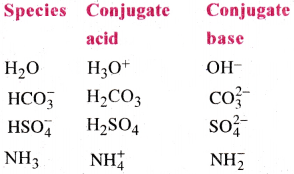
Question 86.
Classify the following species into Lewis acids and Lewis bases and show how these act as such: (a) HO– (b) F– (c) H+ (d) BCl3 Among the following which is incorrect.
1) Hydroxyl ion is a Lewis base, as it can donate an electron lone pair (:OH–)
2) Fluoride ion acts as a Lewis base, as it can donate any one of its 4 electron pairs.
3) A proton is a Lewis acid, as it can accept a lone pair of electrons from bases like hydroxyl ion and fluoride ion.
4) BCl3 acts as a Lewis base, as it can accept a lone pair of electrons from species like ammonia or amine molecules.
Answer:
4) BCl3 acts as a Lewis base, as it can accept a lone pair of electrons from species like ammonia or amine molecules.
Solution :
(a) Hydroxyl ion is a Lewis base, as it can donate an electron lone pair (:OH–)
(b) Fluoride ton acts as a Lewis base, as it can donate any one of its 4 electron pairs.
(c) A proton is a Lewis acid, as it can accept a lone pair of electrons from bases like hydroxyl ion and fluoride ion.
(d) BCl3 acts as a Lewis acid, as it can accept a lone pair of electrons from species like ammonia or amine molecules.
Question 87.
The concentration of hydrogen ion in a sample of soft drink is 3.8 × 10-3 M. What is its pH?
1) 2.42
2) 3.42
3) 4.42
4) 5.42
Answer:
1) 2.42
Solution :
pH = -log[3.8 × 10-3]
= – {log [3.8] +log [10-3]}
= – {(0.58) + (-3.0) } = -{-2.42} = 2.42
∴ pH of the given soft drink is 2.42.
Question 88.
Calculate pH ofa 1.0 × 10-8 M solution of HCl.
1) 5.98
2) 7.98
3) 6.98
4) 8.98
Answer:
3) 6.98
Solution :
2H2O(l) ⇌ H3O+(aq) + OH–(aq)
Kw = [OH–][H3O+] = 10-14
Let x = [OH–] = [H3O+] from H2O.
The H3O+ concentration is generated
(i) from the ionization of HCl dissolved.
HCl(aq) + H2O(l) ⇌ H3O+(aq) + Cl–(aq),
(ii) from ionization of H2O
In these very dilute solutions, both sources of H30+ must be considered.
[H3O+] = 10-8+ x
Kw = (10-8 + x)(x) = 10-14
⇒ x² + 10-8 x – 10-14 = 0
∴ [OH–] = x = 9.5 × 10-8
⇒ pOH = 7.02 and pH = 6.98
![]()
Question 89.
The pKa of acetic acid and pKb of ammonium hydroxide are 4.76 and 4.75 respectively. Calculate the pH of ammonium acetate solution.
1) 7.005
2) 8.005
3) 4.005
4) 9.005
Answer:
1) 7.005
Solution :

Question 90.
Which of the following is not a general characteristic of equilibria involving physical processes?
1) Equilibrium is possible only in a closed system at a given temperature.
2) All measurable properties of the system remain constant.
3) All the physical processes stop at equilibrium.
4) The opposing processes occur at the same rate and there is dynamic but stable condition.
Answer:
3) All the physical processes stop at equilibrium.
Question 91.
We know that’the relationship between Kc and Kp is Kp = Kc (RT)∆n
What would be the value of n for the reaction NH4Cl(s) ⇌ NH3(g) + HCl(g)
1) 1
2) 0.5
3) 1.5
4) 2
Answer:
4) 2
Question 92.
The equilibrium constants of the following are
The equilibrium constant (K) of the reaction:
2NH3 +|o2 ^=±2N0 + 3H20 will be
1) K2K³3 / K1
2) K2K3 / K1
3) K³2K3 / K1
4) K1K³3 / K2
Answer:
1) K2K³3 / K1
Question 93.
For the reaction H2(g) + I2(g) ⇌ 2HI(g) the standard free energy is ∆G° > 0.The equilibrium constant (K) would be
1) K = 0
2) K > 1
3) K = 1
4) K < 1
Answer:
4) K < 1
Question 94.
Hydrolysis of sucrose is given by the following reaction:
Sucrose + H2O ⇌ Glucose + Fructose
If the equilibrium constant (KC) is 2 × 1013 at 300K, the value of ∆rG° at the same temperature will be
1) -8.314 Jmol-1 K-1 × 300K × ln(2 × 1013)
2) 8.314Jmol-1K-1 × 300K × ln(2 × 1013)
3) 8.314 Jmol-1K-1 × 300K × ln(3 × 1013)
4) -8 314 Jmol-1 K-1 × 300K × ln(4 × 1013)
Answer:
1) -8.314 Jmol-1 K-1 × 300K × ln(2 × 1013)
![]()
Question 95.
For the reversible reaction,
N2(g) + 3H2(g) ⇌ 2NH3(g) + heat
The equilibrium shifts in forward direction
1) by increasing the concentration of NH3(g)
2) by decreasing pressure
3) by decreasing the concentrations of N2(g) and H2(g)
4) by increasing pressure and decreasing temperature
Answer:
4) by increasing pressure and decreasing temperature
Question 96.
Which one of the following conditions will favour maximum formation of the product in the reaction
A2 (g) + B2 (g) ⇌ X2(g), ∆rH = -XkJ?
1) Low temperature and high pressure
2) Low temperature and low pressure
3) High temperature and high pressure
4) High temperature and low pressure
Answer:
1) Low temperature and high pressure
Question 97.
Acidity of BF3 can be explained on the basis of which of the following concepts?
1) Arrhenius concept
2) Bronsted Lowry concept
3) Lewis concept
4) Bronsted Low ry as well as Lewis concept
Answer:
3) Lewis concept
Question 98.
Conjugate base for Bronsted acids H2O and HF are
1) H3O+ and H2F+, respectively
2) OH– and H2F+, respectively
3) H3O+ and F–, respectively
4) OH– and F+, respectively
Answer:
4) OH– and F+, respectively
Question 99.
Which of the following cannot act both as Bronsted acid and as Bronsted base?
1) HSO–3
2) NH3
3) HCl
4) HSO–4
Answer:
3) HCl
Question 100.
The pKb of dimethylamine and pKa of acetic acid are 3.27 and 4.77 respectively at T(K) .The correct option for the pH of dimcthylammonium acetate solution is
1) 6.25
2) 8.50
3) 5.50
4) 7.75
Answer:
4) 7.75
Question 101.
Find out the solubility of Ni(OH)2 in 0.1M NaOH. Given that the ionic product of Ni(OH)2 is 2 × 10-15
1) 2 × 10-13M
2) 2 × 10-8M
3) 1 × 10-13M
4) 1 × 10-8M
Answer:
1) 2 × 10-13M
![]()
Question 102.
Following solutions were prepared by mixing different volumes of NaOH and HCl of different concentrations:
pH of which one of them will be equal to 1?
1) B
2) A
3) D
4) C
Answer:
4) C
Question 103.
pH of a saturated solution of Ca(OH)2 is 9. The solubility product (Ksp) of Ca(OH)2 is
1) 0.5 × 10-10
2) 0.5 × 10-15
3) 0.25 × 10-10
4) 0.125 × 10-15
Answer:
2) 0.5 × 10-15
Question 104.
Ka for CH3COOH is 1.8 × 10-5 and Kb for NH4OH is 1.8 × 10-5. The pH of ammonium acetate will be
1) 7.005
2) 4.75
3) 7.0
4) Between 6 and 7
Answer:
3) 7.0
Question 105.
What will be the value of pH of 0.01 mol dm-3 CH3COOH(Ka = 1.74 × 10-5)?
1) 3.4
2) 3.6
3) 3.9
4) 3.0
Answer:
1) 3.4
Question 106.
Which of the following will produce a buffer solution when mixed in equal volumes?
1) 0.1 mol dm-3 NH4OH and 0.1 mol dm-3 HCl
2) 0.05 mol dm-3 NH4OH and 0.1 mol dm-3 HCl
3) 0.1 mol dm-3 NH4OH and 0.05 mol dm-3 HCl
4) 0.1 mol dm-3 CH4COONa & 0.1 mol dm-3 NaOH
Answer:
3) 0.1 mol dm-3 NH4OH and 0.05 mol dm-3 HCl
Question 107.
In which of the following solvents is silver chloride most soluble?
1) 0.1 mol dm-3 AgNO3 solution
2) 0.1 mol dm-3 HCl solution
3) H2O
4) Aqueous ammonia
Answer:
4) Aqueous ammonia
Question 108.
The solubility of BaSO4 in water is 2.42 × 10-3gL-1 at 298K. The value of its solubility product (Ksp) will be
(Given molar mass of BaSO4 = 233 gmoH)
1) 1.08 × 10-10mol²L-2
2) 1.08 × 10-12mol²L-2
3) 1.08 × 10-14mol²L-2
4) 1.08 × 10-8 mol²L-2
Answer:
1) 1.08 × 10-10mol²L-2
![]()
Question 109.
Concentration of the Ag+ ions in a saturated solution of Ag2C2O4 is 2.2 × 10-4molL-1. Solubility product of 2C2O4 is
1) 2.66 × 10-12
2) 4.5 × 10-11
3) 5.3 × 10-12
4) 2.42 × 10-8
Answer:
3) 5.3 × 10-12